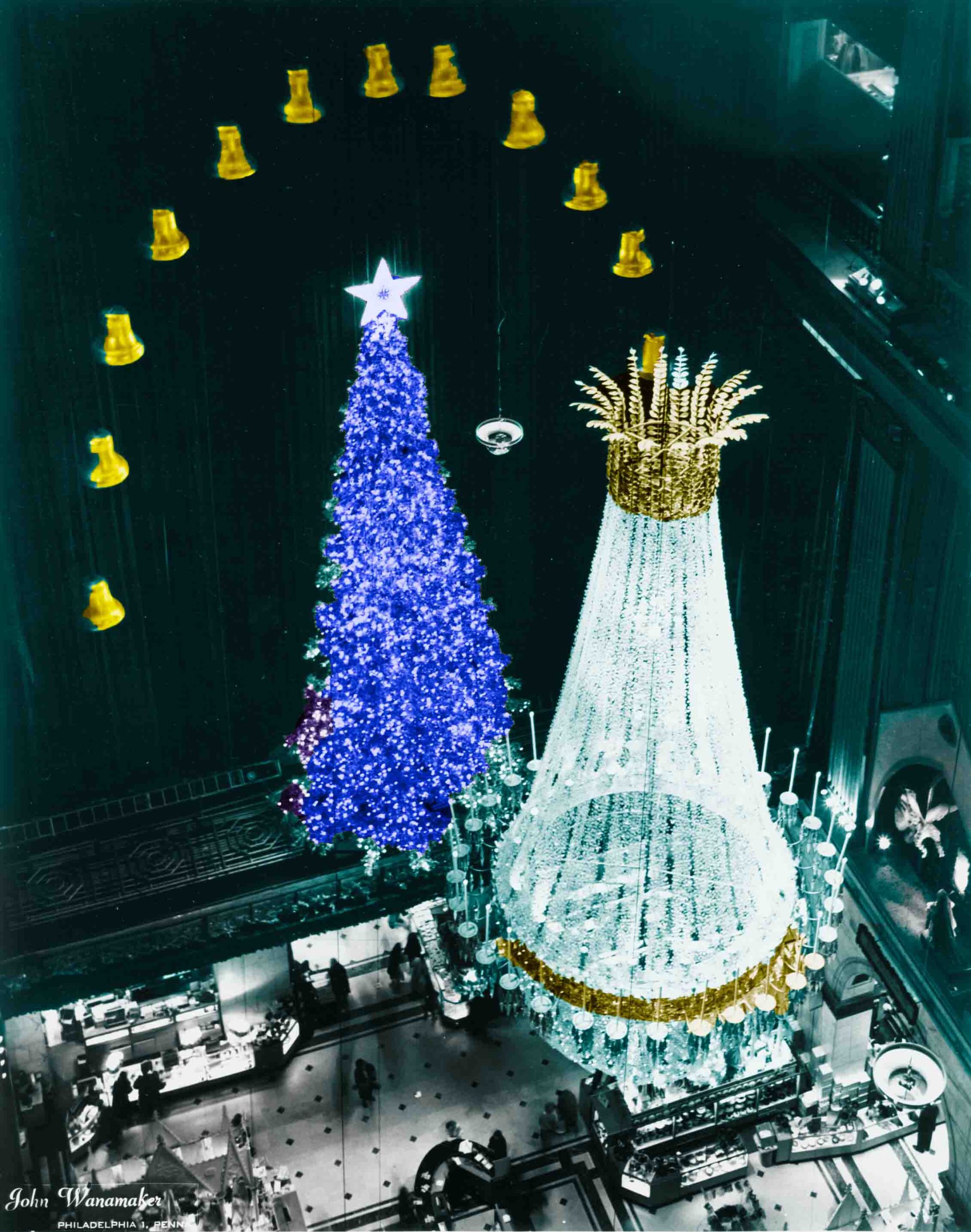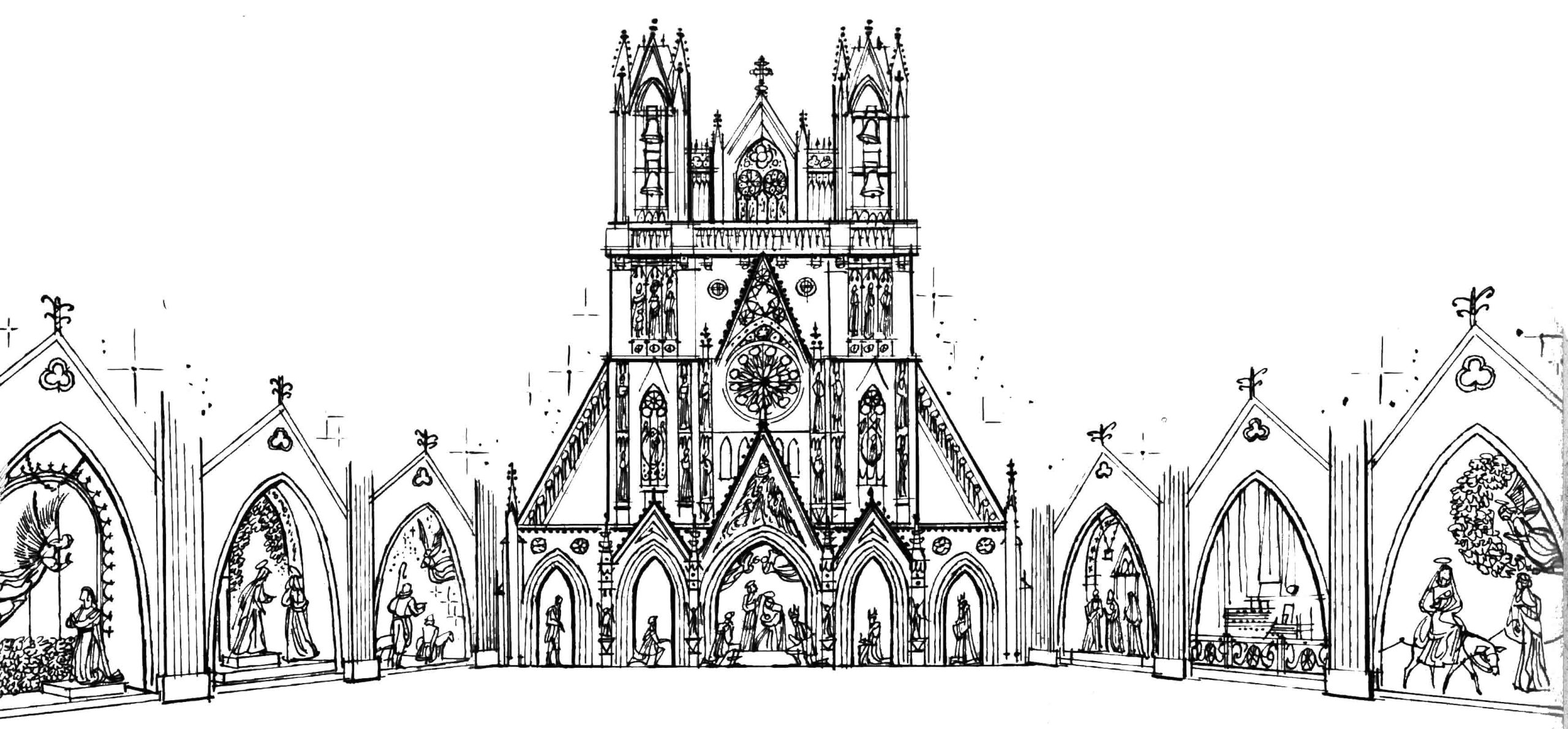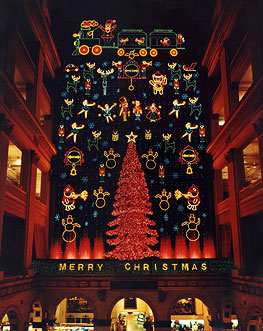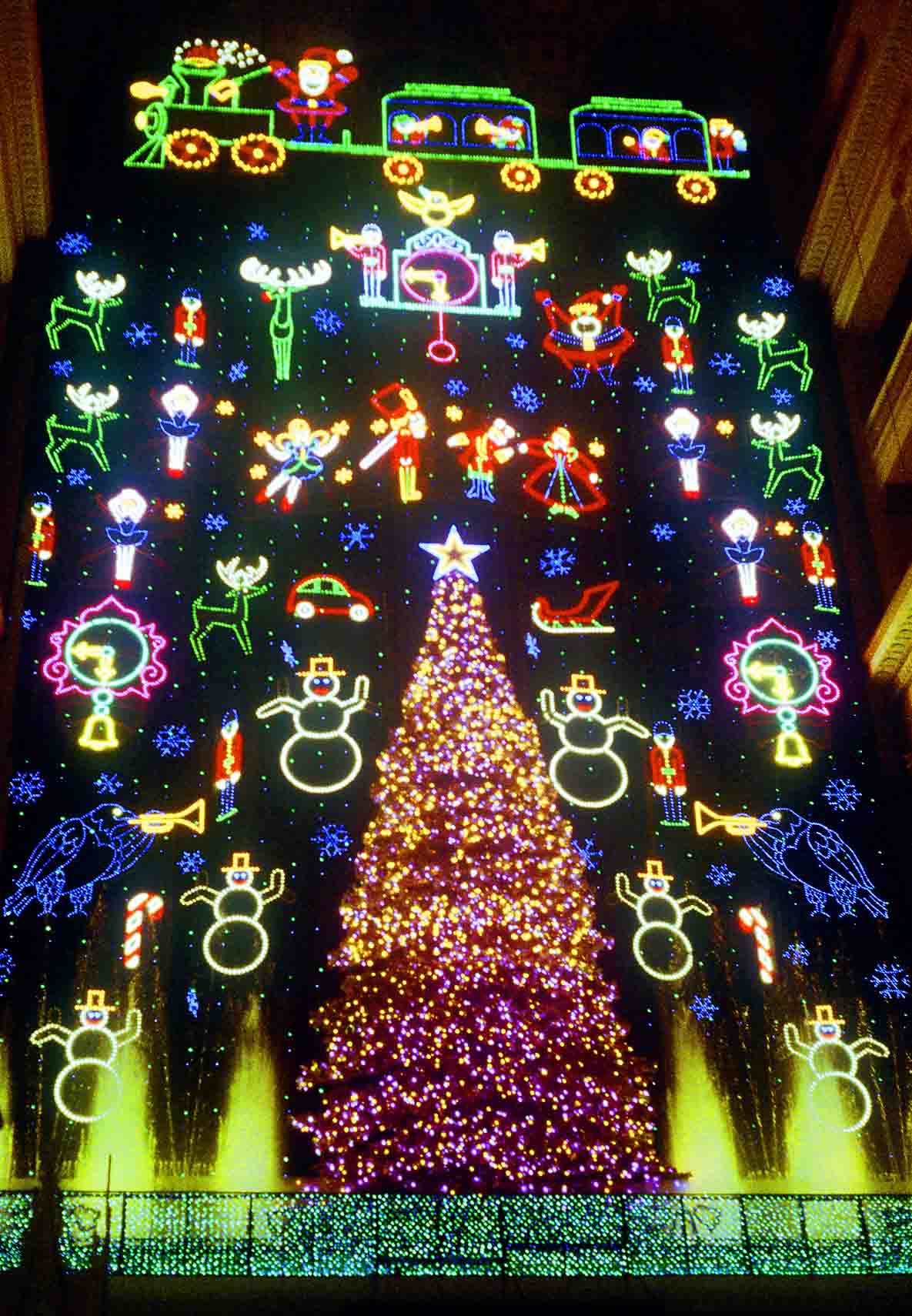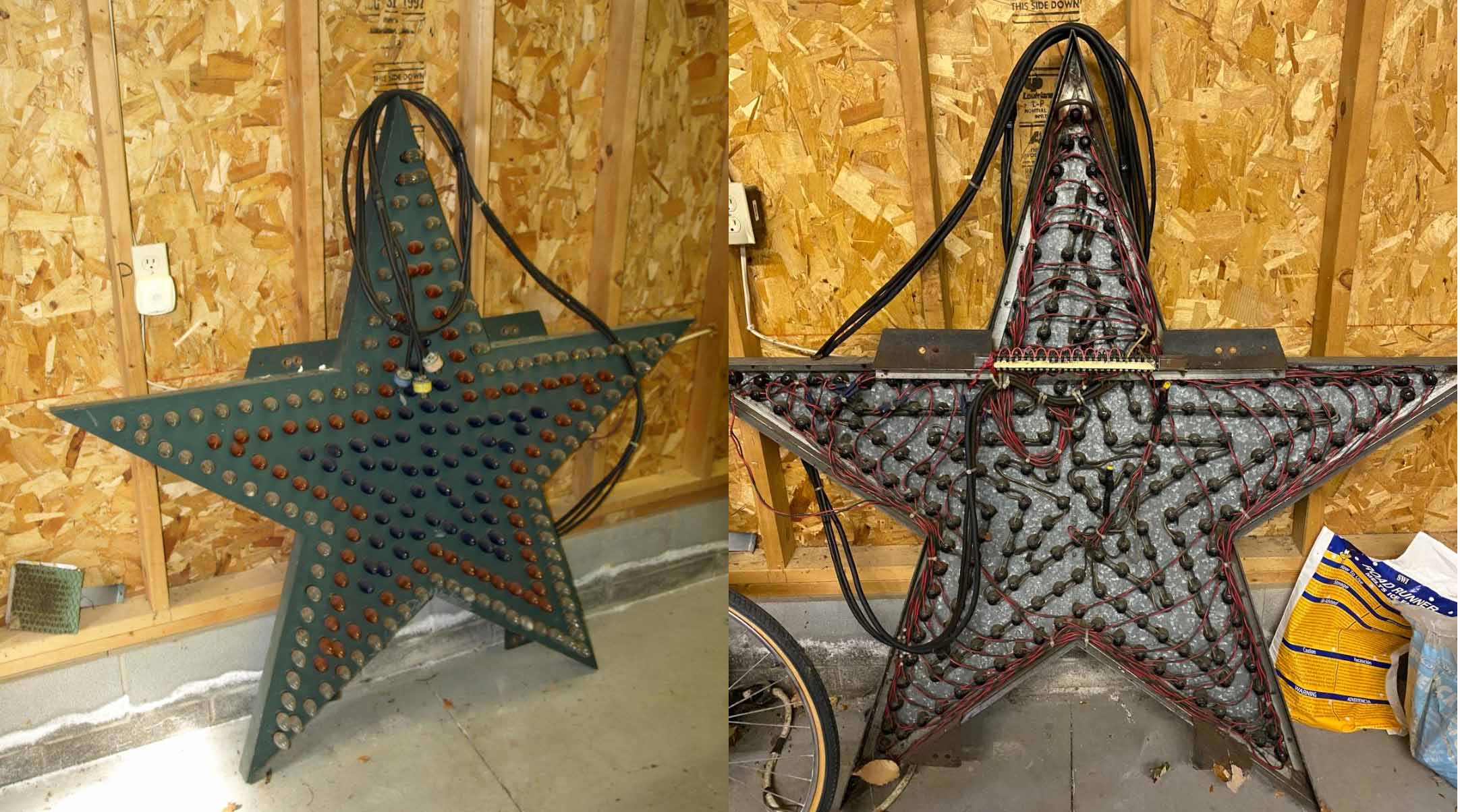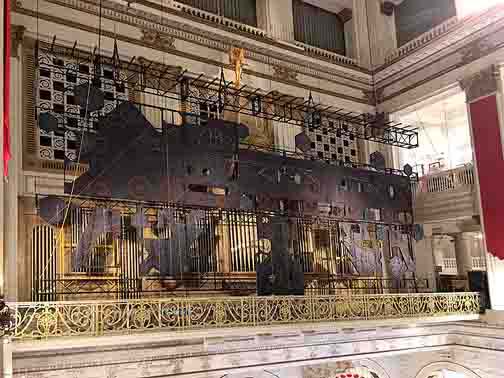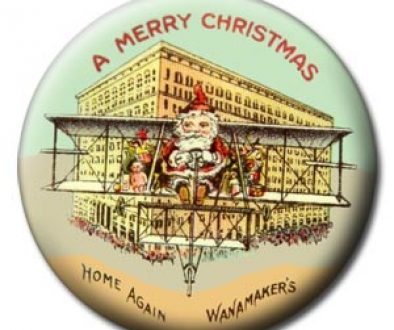Light Show Evolution—with Christmas Display Review
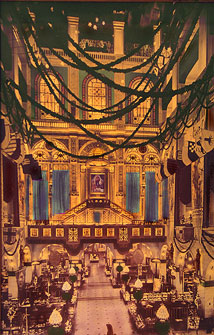 The Store’s fabulous light show has always been one of Philadelphia’s most hallowed traditions since its inception in November 1955, as fountains lit by colored lights. This feature spotlights early Grand Court displays, and it is followed is followed by Larry Kerecman’s information-packed chronology of how the John Wanamaker Light Show evolved year by year.
The Store’s fabulous light show has always been one of Philadelphia’s most hallowed traditions since its inception in November 1955, as fountains lit by colored lights. This feature spotlights early Grand Court displays, and it is followed is followed by Larry Kerecman’s information-packed chronology of how the John Wanamaker Light Show evolved year by year.
Wanamaker’s Light Show was initiated and developed by Frederick M. Yost, a Yale University theater-lighting graduate who came to John Wanamaker in 1948. He pioneered many of the beautiful Grand Court displays that kept the store in the forefront of retailing as Vice President of Sales Promotion.
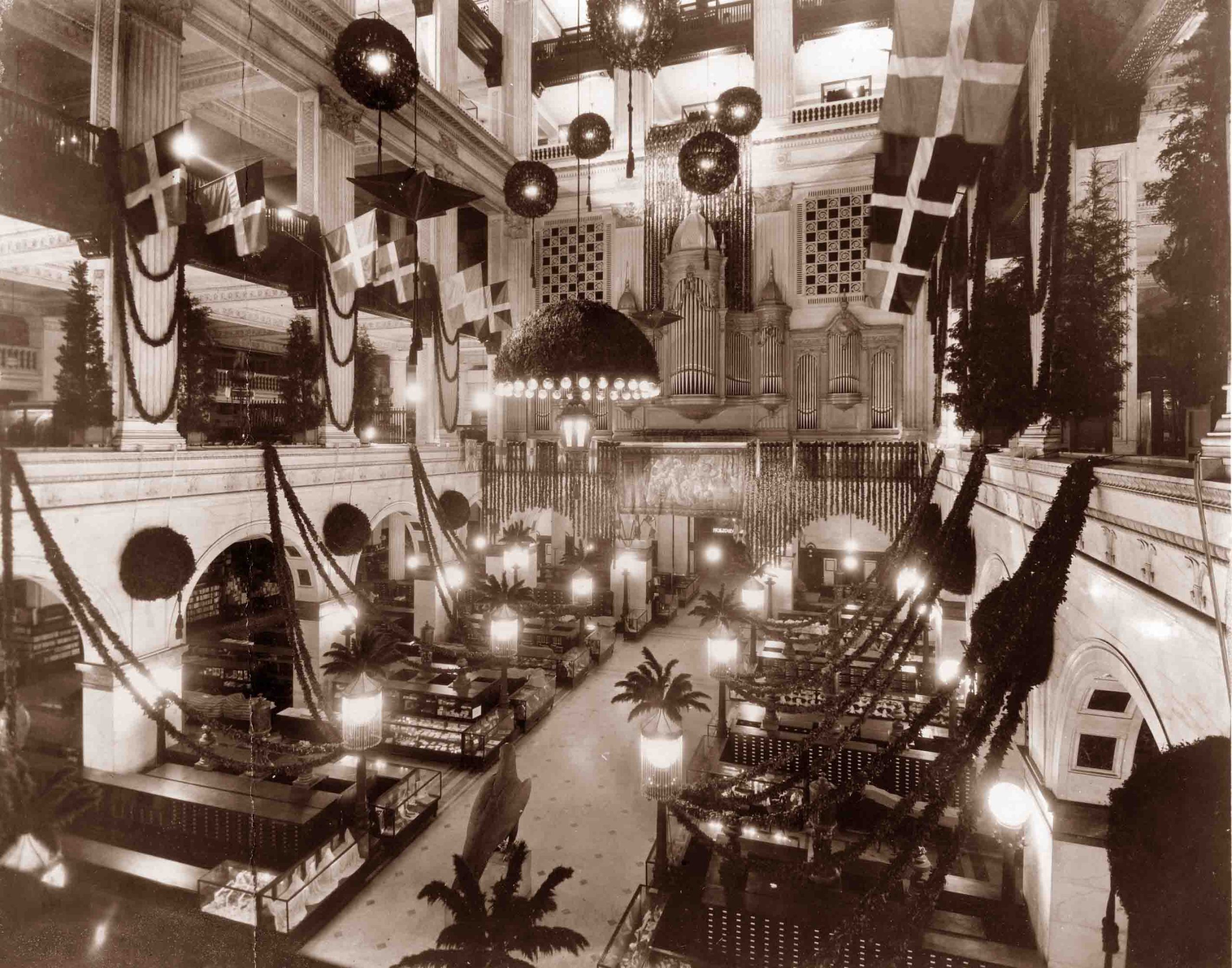 Yost was following a long tradition. Previous Yuletides, stretching back to the era of John and Rodman Wanamaker, featured grandiose Christmas and Easter displays that ran the full height of the Grand Court. Stage-carpentry schemes right out of Hollywood covered the Wanamaker Organ wall with staircases, balconies, draperies, “stained glass,” greenery, knights in shining armor, chariots, chandeliers, horses, silk heraldic banners, paintings and rich tapestries.
Yost was following a long tradition. Previous Yuletides, stretching back to the era of John and Rodman Wanamaker, featured grandiose Christmas and Easter displays that ran the full height of the Grand Court. Stage-carpentry schemes right out of Hollywood covered the Wanamaker Organ wall with staircases, balconies, draperies, “stained glass,” greenery, knights in shining armor, chariots, chandeliers, horses, silk heraldic banners, paintings and rich tapestries. 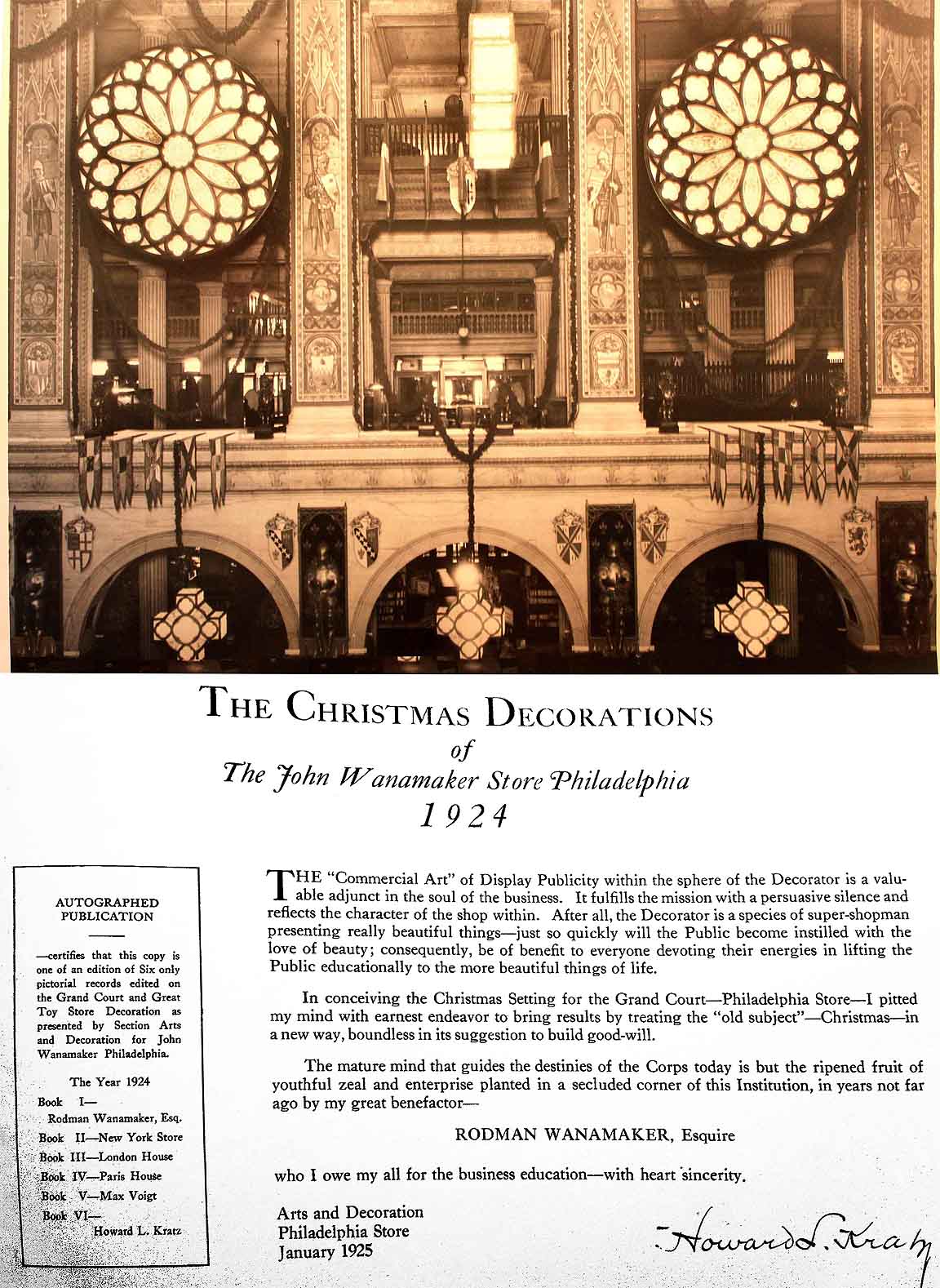 Howard L. Kratz was the highly gifted and imaginative Director and Administrator of Arts Decoration for John Wanamaker Philadelphia. Beautiful leather-bound books of the over-the-top decorating
Howard L. Kratz was the highly gifted and imaginative Director and Administrator of Arts Decoration for John Wanamaker Philadelphia. Beautiful leather-bound books of the over-the-top decorating
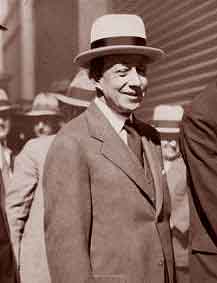
schemes—which were freshly created year after year—are preserved at the Historical Society of Pennsylvania in their Wanamaker collection.
By the time of World War II, a relative austerity set in. The exposed organ case was backed by colored curtains, and giant lit candles rose atop it. Singers in Dickensian costumes sang carols, with the general public joining in. Christmas songbooks were handed out to customers. The Enchanted Fountains were added, dancing to music.
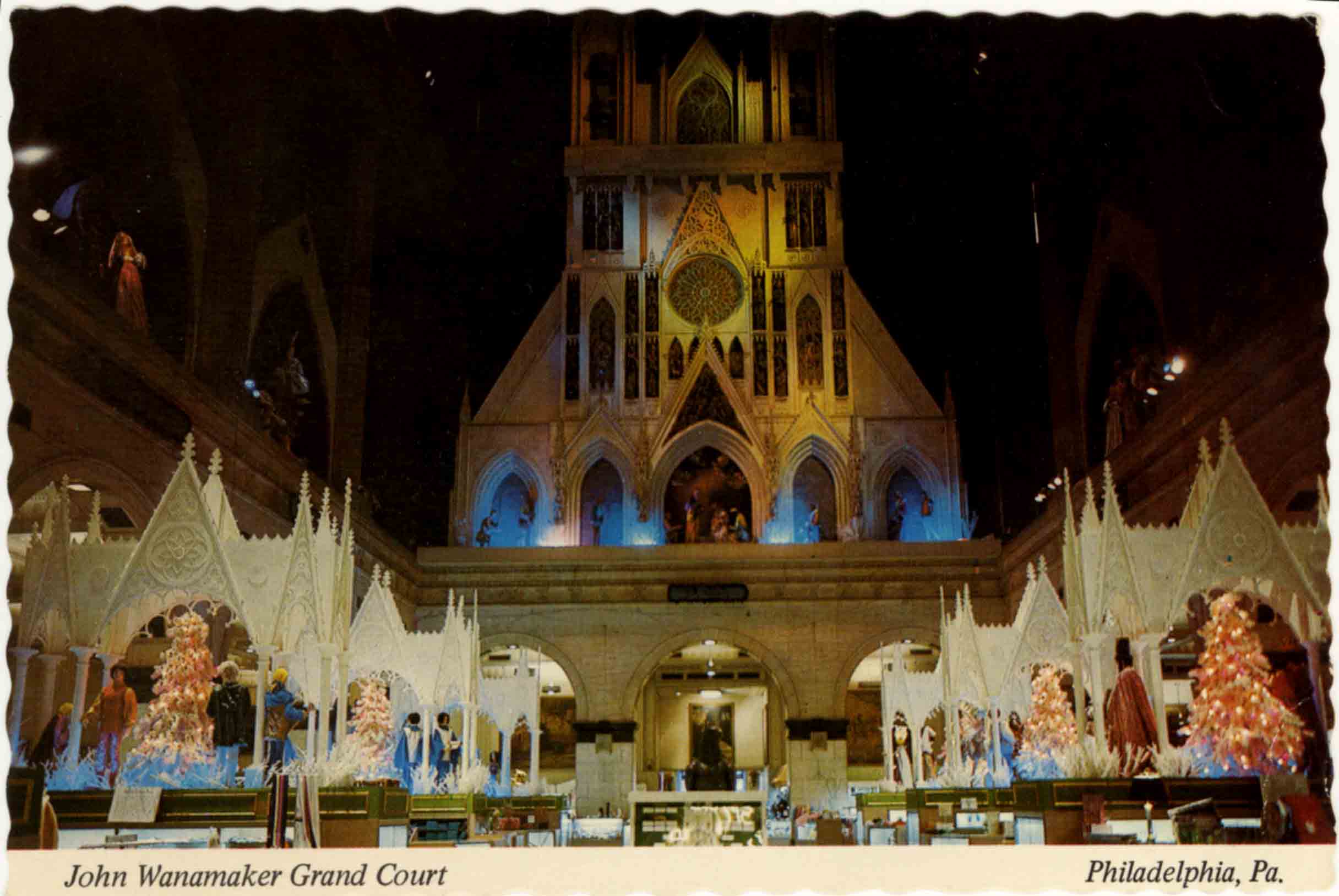
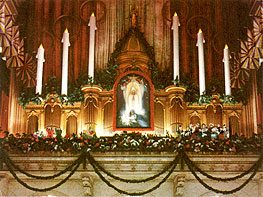
By the 1950s returning servicemen and women were starting families in a big way. Baby Boomers were primed to fall in love with the Organ and the new Christmas decorations planned. Yost took the decorations in a new direction by draping the Organ entirely in thick blue-green curtains that conformed to the curves of the case, and by adding the Magic Christmas Tree to the fountain display. Like the fountains, the huge tree could be lit in any color or mix of colors, and could also be lit in different colors in thirds from the top down. The trunk of the tree—actually a huge electrical strip with color-coded  plugs— was supported by girders inside the central tower of the organ’s pipe screen, and by a boom reaching over the Herald Angel. The frontmost organ pipes were removed to secure the tree. Between shows, the tree patterns slowly changed at random during the shopping day. In the early years, large golden bells hung in an arc around the tree. As for the Organ, it was muffled but was powerful enough to get through the curtain.
plugs— was supported by girders inside the central tower of the organ’s pipe screen, and by a boom reaching over the Herald Angel. The frontmost organ pipes were removed to secure the tree. Between shows, the tree patterns slowly changed at random during the shopping day. In the early years, large golden bells hung in an arc around the tree. As for the Organ, it was muffled but was powerful enough to get through the curtain.
Mirror balls were used to create artificial snowflakes. Reportedly at one time water was also directed out of the balcony and into a main-floor receptacle, but this feature literally dampened customers’ spirits.
![]()
An Incomplete History of the Wanamaker Light Show, the John Wanamaker “Christmas Pageant of Lights”
—by Larry Kerecman (a.k.a. “Light Show Larry”)
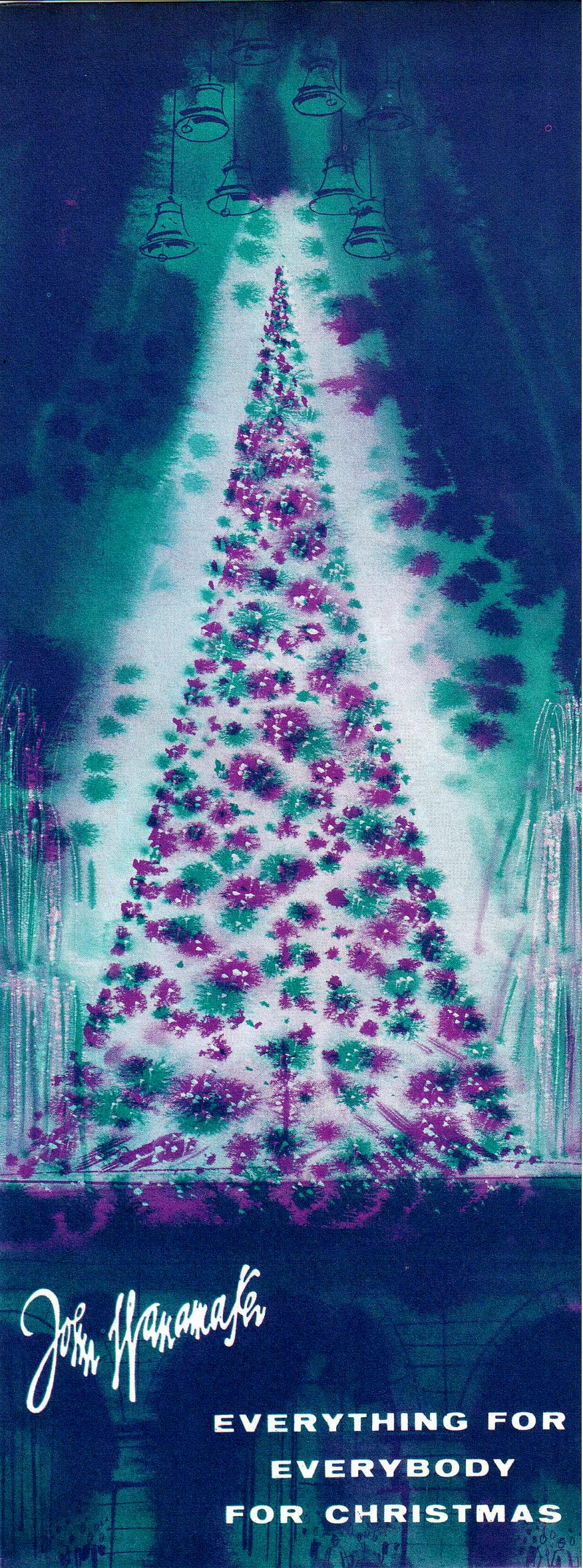
I grew up in Trenton, N.J., with annual holiday trips to Philadelphia to see the Light Show from 1957 to 1964. In 2000, I was engaged by Lord & Taylor to install a new computerized control system to run the show.
I have made revisions to this chronology over time as I came across additional and definitive information and more accurate dates for events. I’m sure more refinements are possible, but this iteration of this document corrects some errors and adds new information.
For the serious student of the Light Show history there are several high-quality resources that can be tapped. The very substantial Fred Yost collection at the Historical Society of Pennsylvania might be a good source, as are papers and drawings contributed to the Friends of the Wanamaker Organ by Bert Medland. Let’s go through the years….
1953: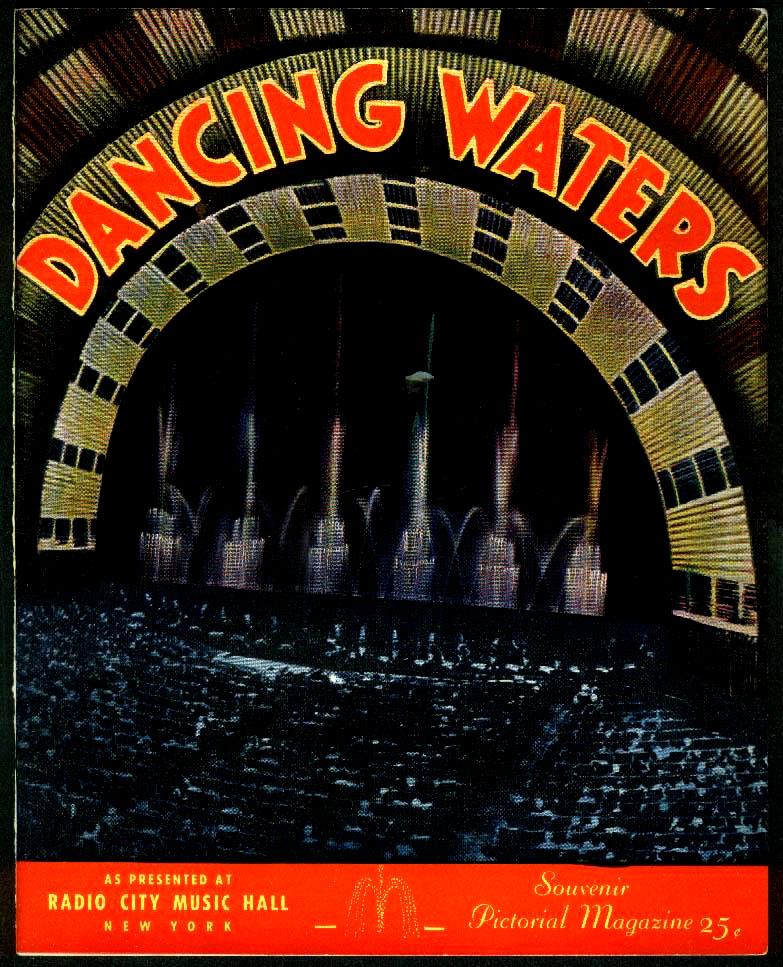
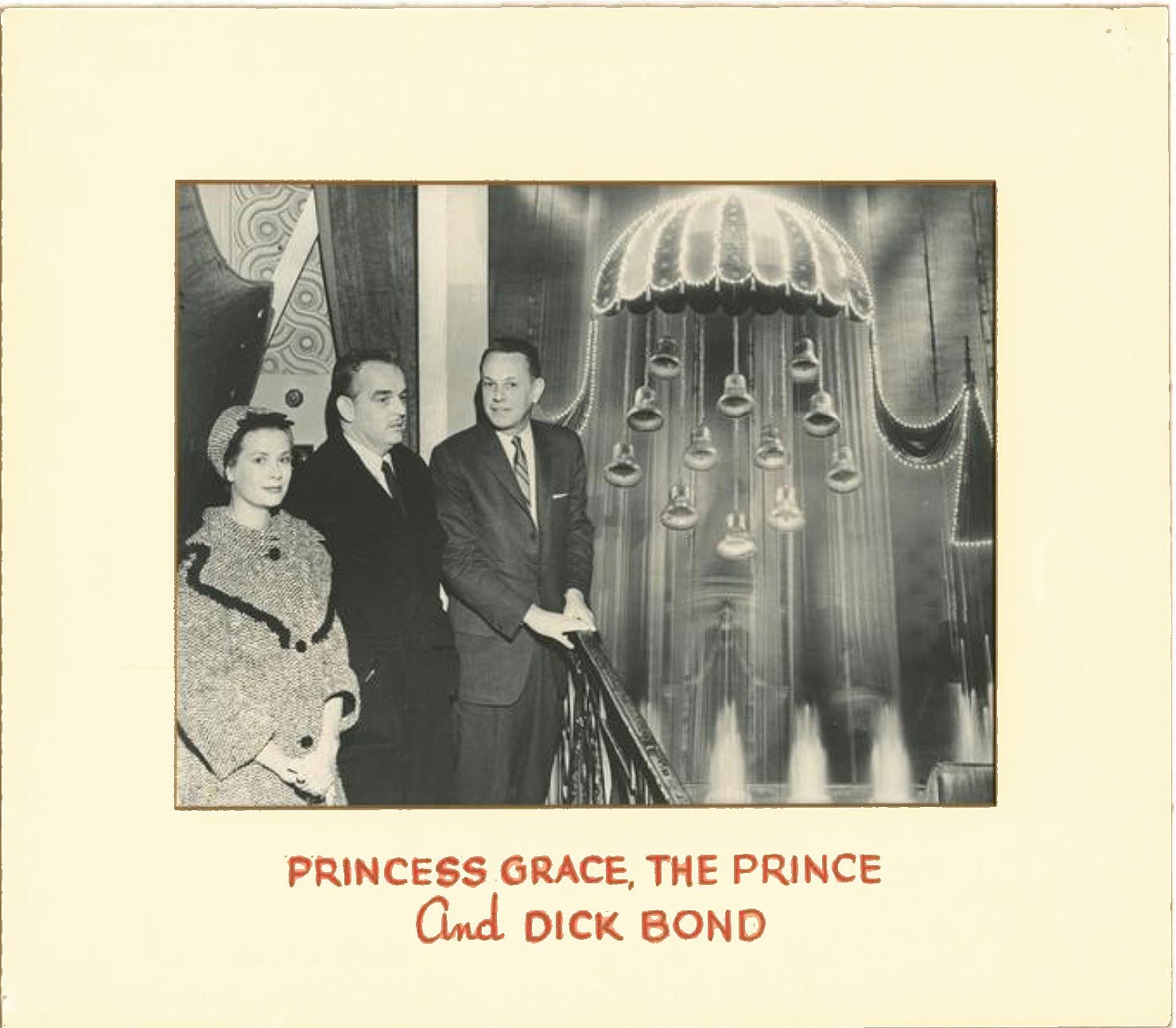
Harold Steinman, a New York showman, had seen the fountains in Germany in the early
1950s, and negotiated exclusive rights to exhibit the show in the United States. He called his American show Dancing Waters. All of the fountain equipment was built in Germany. At one time there were multiple Dancing Waters shows touring the U.S. Each show came with an operator to choreograph the water and lights to music. The show was featured as part of a music festival at Philadelphia’s Municipal Stadium in June 1953. It was so successful it was a headline event there the following June.
1955:
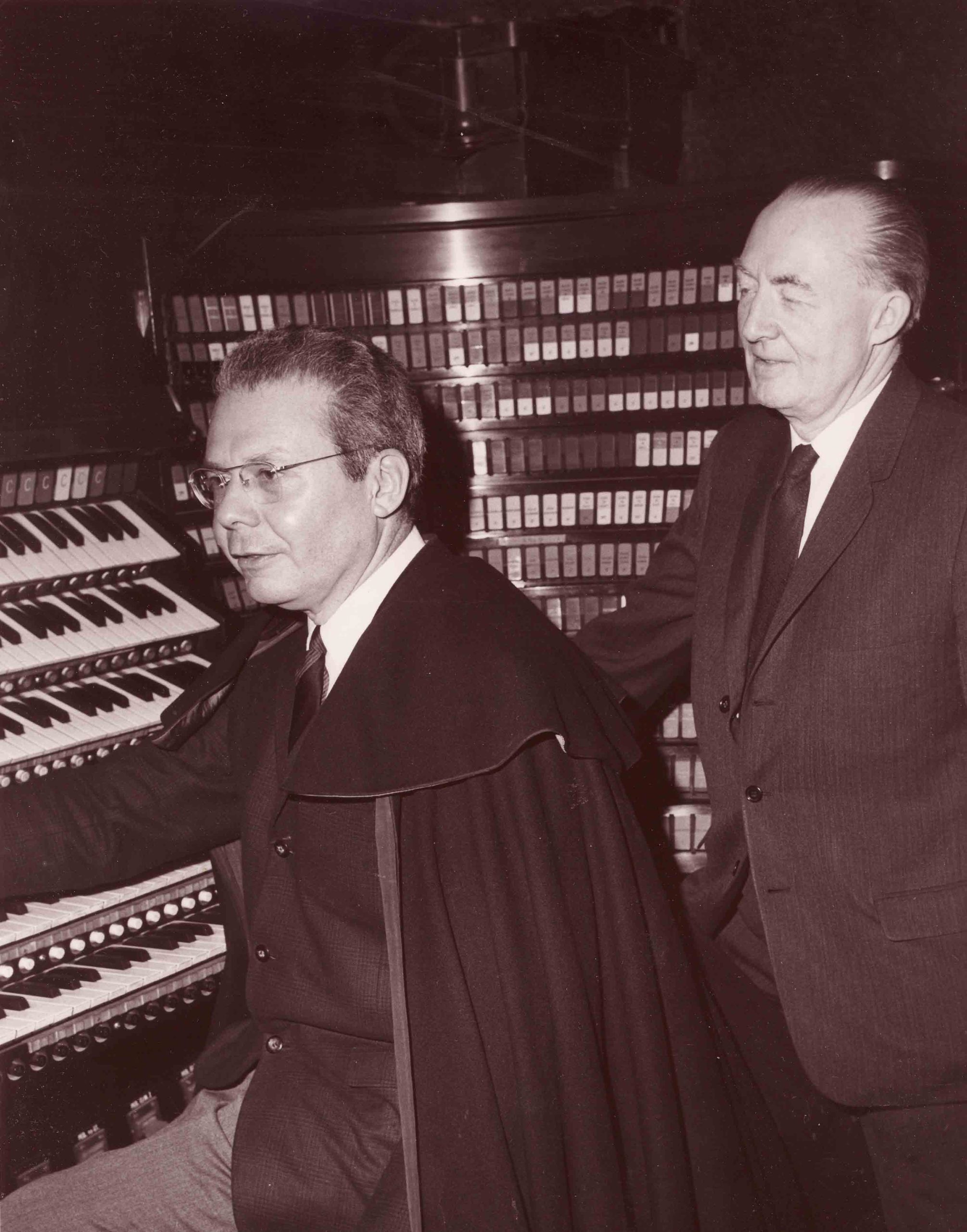
– The famous cathedral façade, designed by Fred Yost, was installed on the north (Market Street) side of the Grand Court. Made of plywood and papier-mache, artfully lit with shifting lighting and adorned with glitter, it reportedly took 10,000 man hours to complete. Around the second floor collonade of the Grand Court in the Gothic arches forming “Cathedral Square” were various scenes reflecting the Nativity story. Below on the countertops were a series of filligreed Gothic arcades and pinnacles bringing the cathedral feel to the main floor.
Chimes changes were rung from the Wanamaker Organ Major Chimes, featuring tunes from Canterbury Cathedral, Cologne Cathedral, Westminster Abbey, Quebec’s St. Anne de Beaupré, Westminster Abbey, Notre Dame de Paris, Philadelphia’s Basilica of SS. Peter and Paul, and other famous belfries.
Unfortunately, the enclosure of the Grand Court with heavy theatrical draperies (including one that covered the Christmas Cathedral each year post-Christmas) did much to destroy the reverberation of the room and dampen the sound of the Wanamaker Organ on a year-round basis.
1956:
– Fred Yost had seen the Dancing Waters show in Germany in 1952 and was impressed by it. Now, four years later, under Yost’s auspices John Wanamaker leased a version of that show from Dancing Waters and set it up their “Enchanted Fountains” on the stage in front of the Wanamaker Organ. (This was likely when the current stage level was raised from the “orchestra pit” in front of the Organ Case and received a suspended extended apron) The 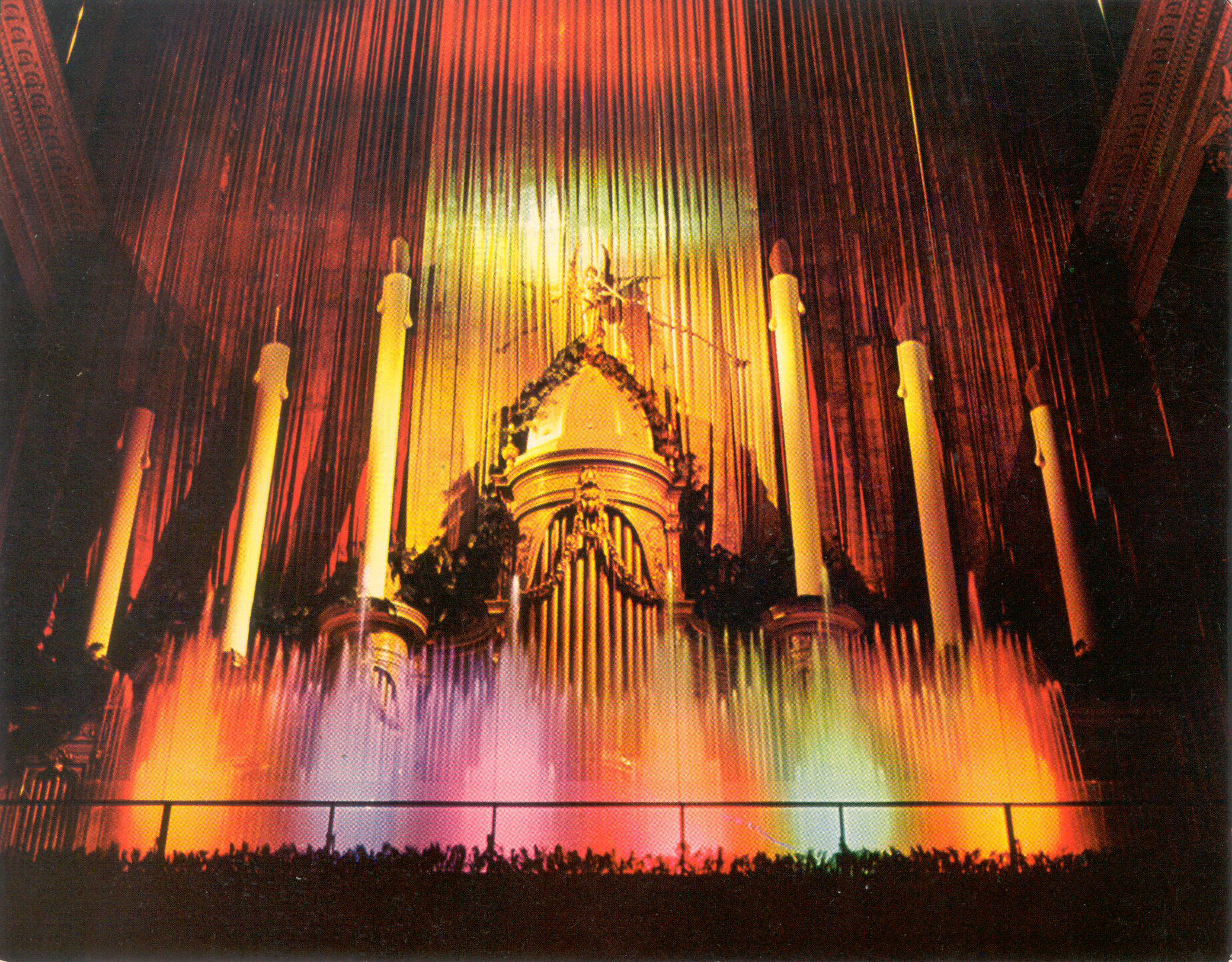
- The fountain and colored lighting controls were completely manual in operation. Thus every performance of the fountains was unique.
- Wrote the Philadelphia Inquirer: “The sixteen pumps created multiple water displays that could be used individually or in ensemble. The Enchanted Fountain’s magic is created by 2500 gallons of water pumped through 7000 individual jets, some stationary and others whirling. The jets are attached to six units of steel piping. The jets of water are controlled by a console, resembling that of a pipe organ, with dozens of switches and buttons. By the flick of a switch or a touch on a button, the two operators can cause the waters to turn, twist and swirl into limitless designs and patterns.”
A unique motorized line of nozzles on each side of the display created the dancing effect by swaying the streams back and forth. Multiple “wedding cakes” – created by concentric rings of vertical streams of water running at four tiered heights – were another signature feature of the fountain show.
- A separate control panel operated the colored lights placed behind the pools of water to illuminate the display.
Yet another manual control panel operated the lights on the props and figures displayed above the fountains.
- An arc of lighted bells was hung in front of the drape, created a colorful backdrop. In subsequent years the bells were joined by lighted candy canes, toys, soldiers, trumpets, snowflakes and, of course, Santa Claus. These were all static figures, but could be turned on and off individually or in groups. A giant lighted crystal chandelier was hung from the Grand Court skylight.
- This is the beginning of having a Christmas show instead of just a Christmas display. A sign on the floor of the Grand Court advertised when the fountains shows will run.
- Eventually a musical sound track is created that features the booming voice of John Facenda introducing the show with the words, “John Wanamaker proudly presents our annual Christmas Pageant of Lights, a brilliant holiday spectacular, depicting the color, warmth and joy of the Yuletide season…”
1959:
– The “breathtaking” 60-foot original “Magic Christmas Tree of a Million Lights” is introduced to the show. The approximately 24,000 7-Watt C-9 lights are in six colors – red, green, blue, amber, pink and purple. The tree lights were divided into three tiers. The six colors of light bulbs were controlled independently in each of the three horizonta sections. Despite its huge consumption of electricity, the tree was set in the middle of the fountain pool of water!
– A star with three colors of lights crowned the tree.
– The tree had a heavy steel trunk holding the 85 individually attached branches and the electrical wires for powering the lights. The tree branches made a 180-degree sweep; the back half of the tree did not have branches so that it fit against the organ façade. Then as now, nonspeaking pipes were removed from the very center of the Wanamaker Organ to support the tree trunk.
– The top of the tree was a cone, without individually attached branches.
– The back of the trunk had hundreds of electrical receptacles. Each of the 85 branches
had six cables that plugged into the color-coded receptacles.
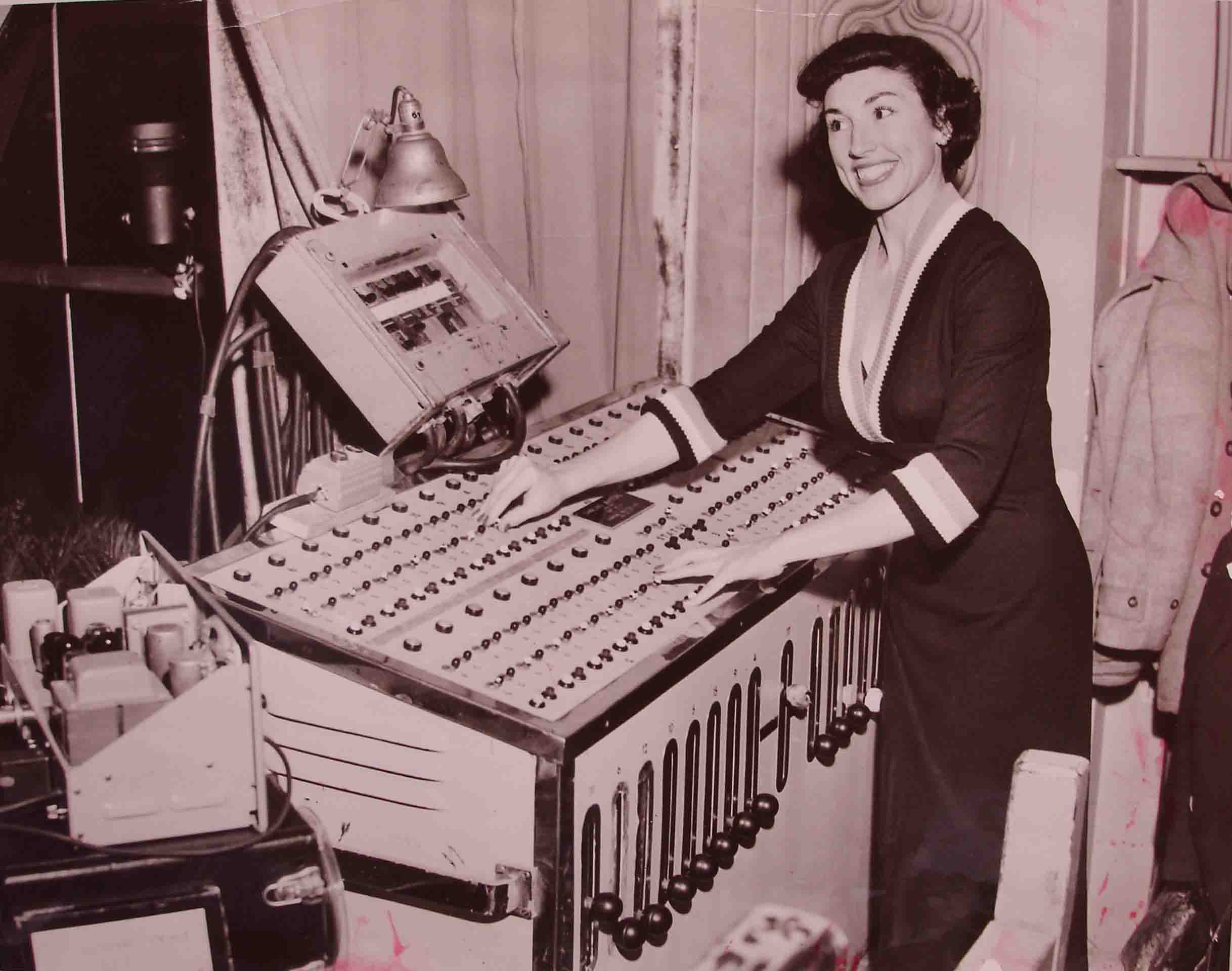
– The tree was fed with eighteen 100-Amp circuits and during the years of the fountain, operation it sat in a pool of 2,300 gallons of water (roughly nine tons of water). (The concept of electrical groundfault protection had not yet been invented.)
– The tree controller was a very sophisticated device, using telephone central-office type
relays for logic control, and mercury relays for power switching.
– A variable speed “lightning effect” dazzle generator flashed the lights rapidly in sequence when the words “starring the breathtaking Magic Christmas Tree” were heard. An “idle time”controller changed the patterns of light colors on the tree at intervals between shows, with the tree often divided horizontally into the three bands of differing colors.
– The tree controller had a massive 1200 Amps of power available, so a maximum of four colors of lights could be on at one time without blowing the main fuses.
Longwood Gardens historian Colvin Randall recalls that during about 1959 or 1960 music from the album “The Spirit of Christmas” was used, with him particularly remembering the selection “The Shepherds
Story,” with music by Clarence Dickinson, among other selections.
1960s to 1975:
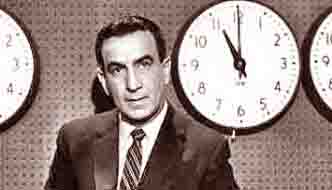
– The Light Show as we know it was created, one song and group of characters at a time. WCAU-TV newsman John Facenda was the host.
– Figures with animation in lights replaced many of the static figures, as the number of animations increased. Each new feature in the show required a new control box to operate it. At first, a small manual control board was used, and then a much larger one was fabricated to accommodate the additional characters and songs.
-28 vertical strings of lights, each with 7 separate circuits, were hung from a platform on the 6th floor. Four circuits of green and blue lights were used for vertical chases, and one circuit of red lights was used for horizontal chases. Both effects were created by motors driving cams that mechanically pushed switches that controlled the lights.
-A circuit of blue blinking lights and another one of white blinking lights created a magical wall of twinkling behind the tree in-between shows.
-The railing in front of the stage was covered in a backdrop of green lights. Amber lights spelling out MERRY CHRISTMAS in large letters were placed in front of that backdrop, and a NEXT SHOW sign was hung below the railing so customers could be there on time.
1961:
– The first light-animated toy figures were created and were choreographed to the “March
of the Toys” song.
(FOR A LISTING OF LIGHT SHOW MUSIC, CLICK HERE)
1962:
– The song “White Christmas” introduced the snowflakes “floating” down. Revolving mirror balls lit by spotlights created optical snow projections. Yost would go on to pick future musical numbers as the Light Show developed.
1963:
– A waterfall was created from the stage to the main sales floor. It lasted only one year because of technical problems and water splashing.
1964:
– The six Frosty Snowmen were introduced with their own song.
1965:
– Rudolph the red-nosed reindeer and the eight other reindeer were introduced with their
own song. Santa was a separate figure.
1966:
– The Department Store Economist magazine features the Light Show and Dancing
Waters fountains on the front cover of the May issue. The heavy drape covering the
entire pipe organ is seen in the picture, along with a more elaborate display of lighted
figures. Except for a drum and a sleigh, none of the other figures seen in this
photograph still exist, but the snowflake and soldier forms were re-created in a later
version of the show.
1967:
– The train is introduced into the show with its own song. Santa appears as the engineer. Eventually the separate Santa is removed from the show, and the train Santa is used in the “Rudolph” song.
-The train is the most complicated figure created for the show—in size, number of lights and number of circuits used.
-For example, the “smoke” coming out of the stack has four circuits of white lights and four circuits of red lights to make the desired animation.
-The wheels on the engine and cars are even more complicated. In order for it to look like the wheels are turning, there are 16 separate circuits for the rims and spokes. The wheels can be made to look like they are going forward or backward by reversing the sequence. All this is done with control box motors, cams and switches.
1968:
– The Nutcracker story is added to the show. Mrs. Fred Yost (Jessie) provides the narration. This is the second most complex set of figures to be made. First there is the sequence of the nutcracker cracking the nut and the pieces falling to the ground. Then there is the nutcracker turing into a handsome prince, and Maria turning into a princess.
-Then the Sugar Plum Fairy does her magic and the four ballerinas are animated in dance, with each figure having three positions for each arm and leg. Like the rest of the show, the choreography of the ballerinas was all done with electro-mechanical switching in a specially built Nutcracker control box.
-Rudolph the Red Nosed Reindeer also lit up the scene with his sleigh-mates.
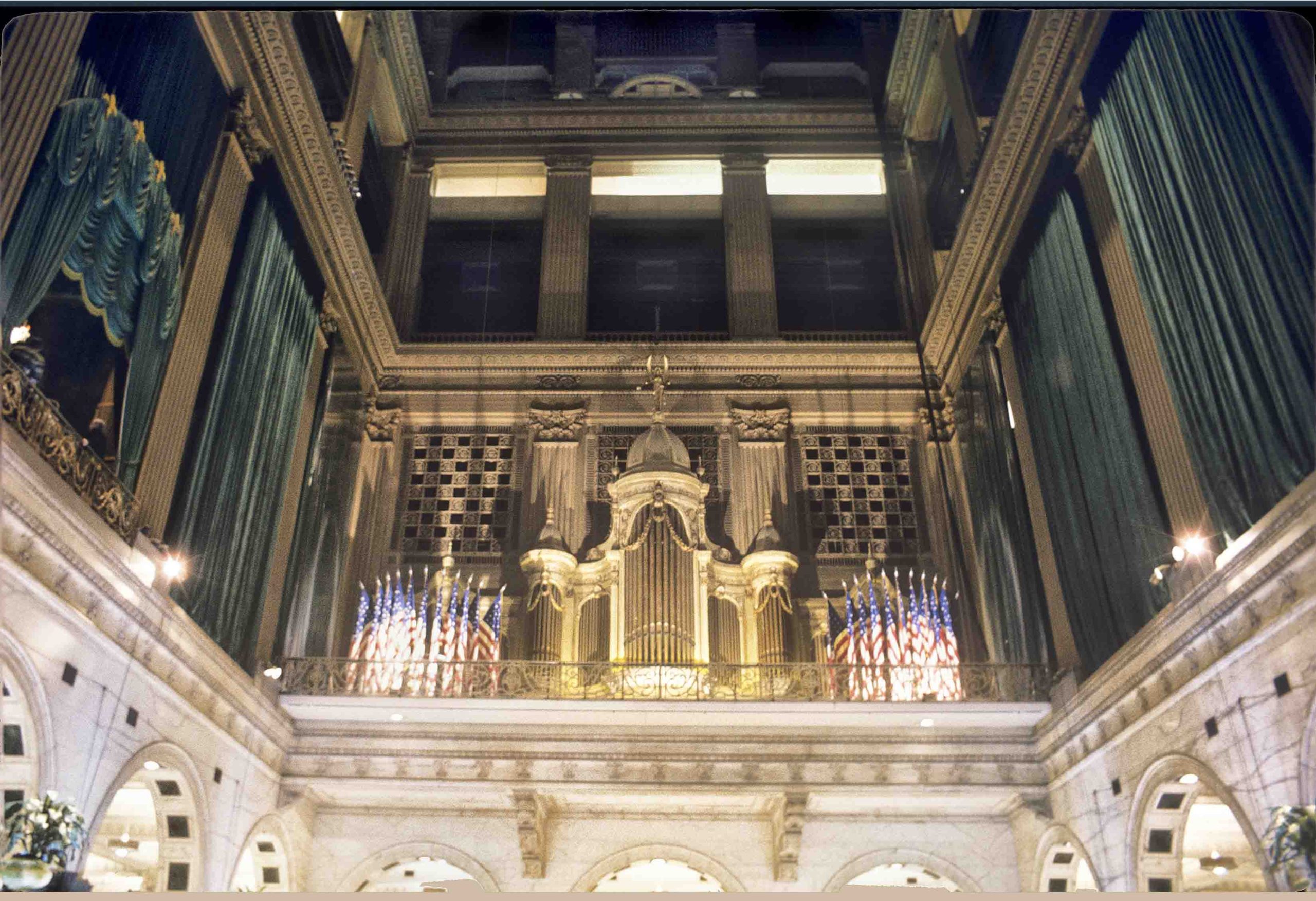
1970:
– The Wanamaker Eagles make their appearance at the bottom of the show. They have trumpets, but no lights emulating sounds coming out of them, unlike the later Rudi Bears taking their place.
197?:
Early in the decade, one of the trumpets of the angel is knocked down. It is eventually returned.
– The first light show programming system is created, using an open-reel tape player as the source of music and data.
– After many years of leasing the Dancing Waters fountain show (and their operators),
Wanamaker’s purchases the equipment and trains store personnel to run the show.
(In researching the fountain show to automate it in 2000 (a project that got cancelled by
Lord & Taylor), I was originally confused by pictures that showed four fountain “wedding
cakes” on each side of the tree. The equipment in storage at the store had only three
sections for each side. It turns out that the four-per-side show was the leased
equipment.)
– During the mid-seventies and early eighties, several new light-animated figures
appeared for one season, such as Santa Claus waving a banner saluting the
Philadelphia Phillies as World Series champs (1980), and E.T. the Extra-Terrestrial (1982).
c. 1977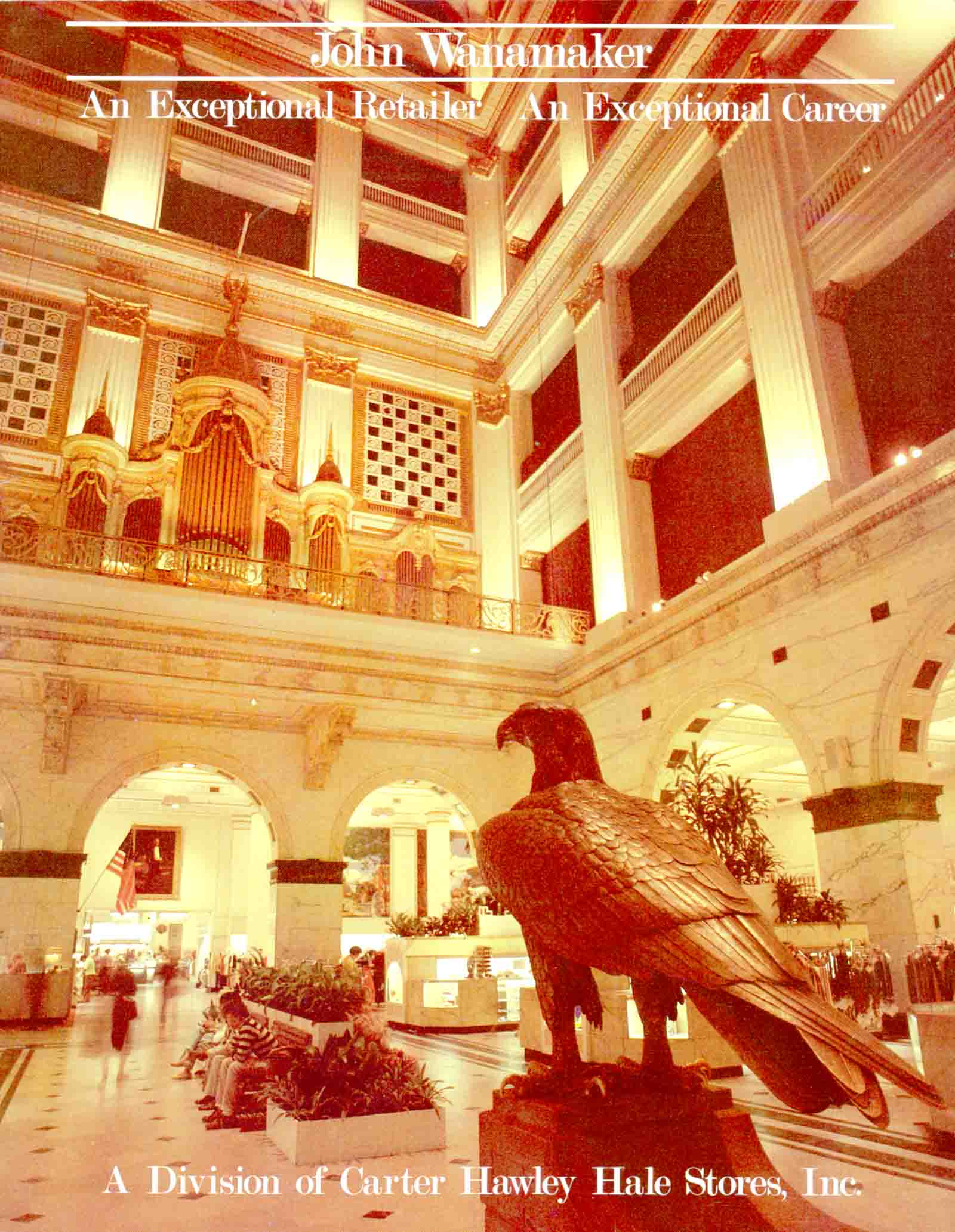
1978:
– The Wanamaker stores are purchased by Carter Hawley Hale and continue to operate as John Wanamaker. During this time there remained ten selling floors in the Philadelphia flagship, with various clubrooms and customer services on galleries.
1986:
– The Wanamaker stores are sold to Woodward and Lothrop (run by A. Alfred Taubman). Merchandise for the two chains is cross-labeled.
– Rudi Bear makes his first appearance – tied in with the sale of a Rudi Bear teddy bear promotion in the store, replacing the Wanamaker Eagles. The big Rudi Bear has a drum that he beats in time with the music; the two small Rudi Bears have trumpets with 12 circuits of lights to simulate sound waves coming out of their trumpets. Rudi Bear teddybears return the next year.
HARNESSING THE SHOW TO A COMPUTER
1988:
– The Wanamaker building is sold after 3 years of renovation.
– Five floors remain as John Wanamaker retail space; other floors become office space with a separate entrance on Juniper Street. The upper floors of the Grand Court are enclosed in glass, improving the reverberation of the Wanamaker Organ.
-Paul Fritts from Innovatek installs an IBM PC to run the show. The open reel audio tape playing the monophonic sound track has the control signals recorded in “real time” from the manual control panel onto the second audio track.
A special interface connects the audio signal to the PC and a custom C++ program outputs multiplexed data to a rack of decoders. These decoders then connect to the old relay interface, which then connects to the individual show figure controllers.
-The big manual control panel is retained so that if the computer system fails the show can go on.
1992:
– The neon Merry Christmas sign is added to the stage railing.
– The Grand Court arches are outlined using rope light with a chase sequencer.
BANKRUPTCY
1994:
– Taubman allows the Woodward and Lothrup and the Wanamaker stores to go bankrupt.
THE MAY COMPANY ERA
1995:
– The May Company buys the store and makes it part of the Hechts chain. A Washington D.C. area newsman lends his voice as the new host.
THE SOUNDTRACK GOES DIGITAL
1997:
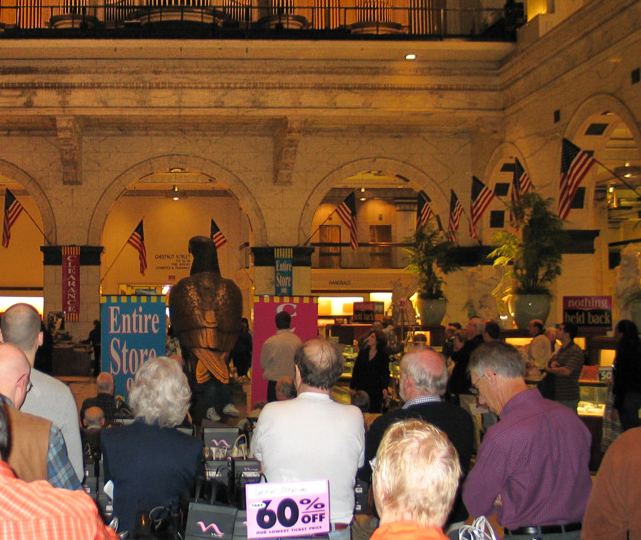
– After the May Company buys Strawbridges, the store is temporarily named Strawbridges (its longtime rival). It undergoes a renovation, closes briefly, is reduced from five to three floors, and reopens as a Lord & Taylor store (another May division). More of the Grand Court is now enclosed in glass, further enhancing the presence and reverberation of the Wanamaker Organ.
– A DAT player is substituted for the analog tape machines to run the sound track.
THE SHOW MUST GO ON
1999:
– During Lord & Taylor ownership Al Goessler, the last remaining Wanamaker Light Show technician, leaves the show. According to his website, Goessler had been with the show since 1965.
– Store engineers and New York personnel attempt to install and run the show on their
own. Many problems are encountered with fountain assembly, fountain lighting, rigging,
connectors, bad solder joints in controllers and assembling the tree. Water is shot up
into the 3rd floor children’s department during testing.
– Reportedly, no documentation of any kind is found for the Light Show equipment.
– When things are not coming together, store engineers are brought in from as far as
Baltimore to work on the show.
– The 1999 Light Show is run from the first generation computer control system; a DAT
tape provides the sound track and coded audio trigger signals; an IBM PC with custom
C+ program decodes the trigger signals and connects to custom interfaces that operate
the relays attached to the manual control system.
– The Show uses all figures – including six snowmen and lots of snowflakes, the Magic
Christmas Tree, Dancing Waters fountains, neon Merry Christmas sign on the stage
railing and heavy green drape over the Organ.
– Two people run each show – one to start and monitor the controls and one to operate
the fountain show from the manual control console.
– About 90% of the show worked for the 1999 season. While Curt Mangel is consulting on
the pipe organ, he is asked by John Imperatore (regional engineering manager) if he has
any ideas on what to do.
– Curt and John call Larry Kerecman in Denver, who happens to be building a miniature
copy of the Magic Christmas Tree on his front porch when the call comes in.
COMPUTERS SUPPLANT RELAYS AS THE WANAMAKER ORGAN EMERGES FROM ITS ANNUAL WINTERTIME COCCOON
2000:
– January 4 – Larry Kerecman with Control Dimensions arrives in Philadelphia, inspects
the equipment and sees it in operation (except for the fountains, which were drained.)
– March – a new computerized control system is proposed for the Light Show and Dancing
Waters fountains. All programming is done with software, not hardwired relay logic. The Horizon show control system used for theme parks is employed.
The audio track is burned on a CD and the syncronization between the music and the lights will use the SMPTE time code, with timin accurate to 1/30 of a second.
-All show programming is done in software, very different from the hardwired relay logic and motorized timers originally developed and built by Bert Medland when all of the light- animated characters were originally created.
– June – the new control system is approved for design.
– July-August – the old control system is removed; basic programming for new control
system is done in Denver by lighting and show cue designer Jim Sale, by watching videotapes of the old show over 100 times to understand the synchronization of the music to the original show for an authentic reproduction.
– Curt Mangel works on using thin black scrim to eliminate the heavy velvet drape over the organ and asks if new organ façade lighting could be part of the new Light Show installation. This is approved by L&T in New York.
– With the organ façade planned to be visible during the Light Show (as it was at Christmas in the mid-1950s) Larry Kerecman designs new multi-color organ façade lighting to replace the “bathroom lights” (cove lights) that had illuminated the pipes for many years. This included red, green, blue and white floodlights, spotlights for the Herald Angel and red and amber uplights for the pipe towers.
A decision is made to discontinue the fountain show due to expense and electrical safety issues.
– Plans are made to include the Wanamaker Organ in the grand finale of the Light Show. It will be live when an organist is available and recorded when not available.
– Based on Wanamaker organist Peter Richard Conte’s experience at the Mormon Tablernacle in Salt Lake City, a small drawer is added to the organ console to provide controls for the new organ façade lighting, microphone and store background music system. Multi-color lighting presets are programmed for the buttons.
– September-November – new power distribution, switching panels and a dimmer rack are installed; the new control system is installed.
– The show figures are hung early in the season for testing. Since there is no documentation available for the original show wiring, each circuit is individually tested by connecting it to power and then seeing what lights up on a figure. There are over 350 individual light circuits in the show.
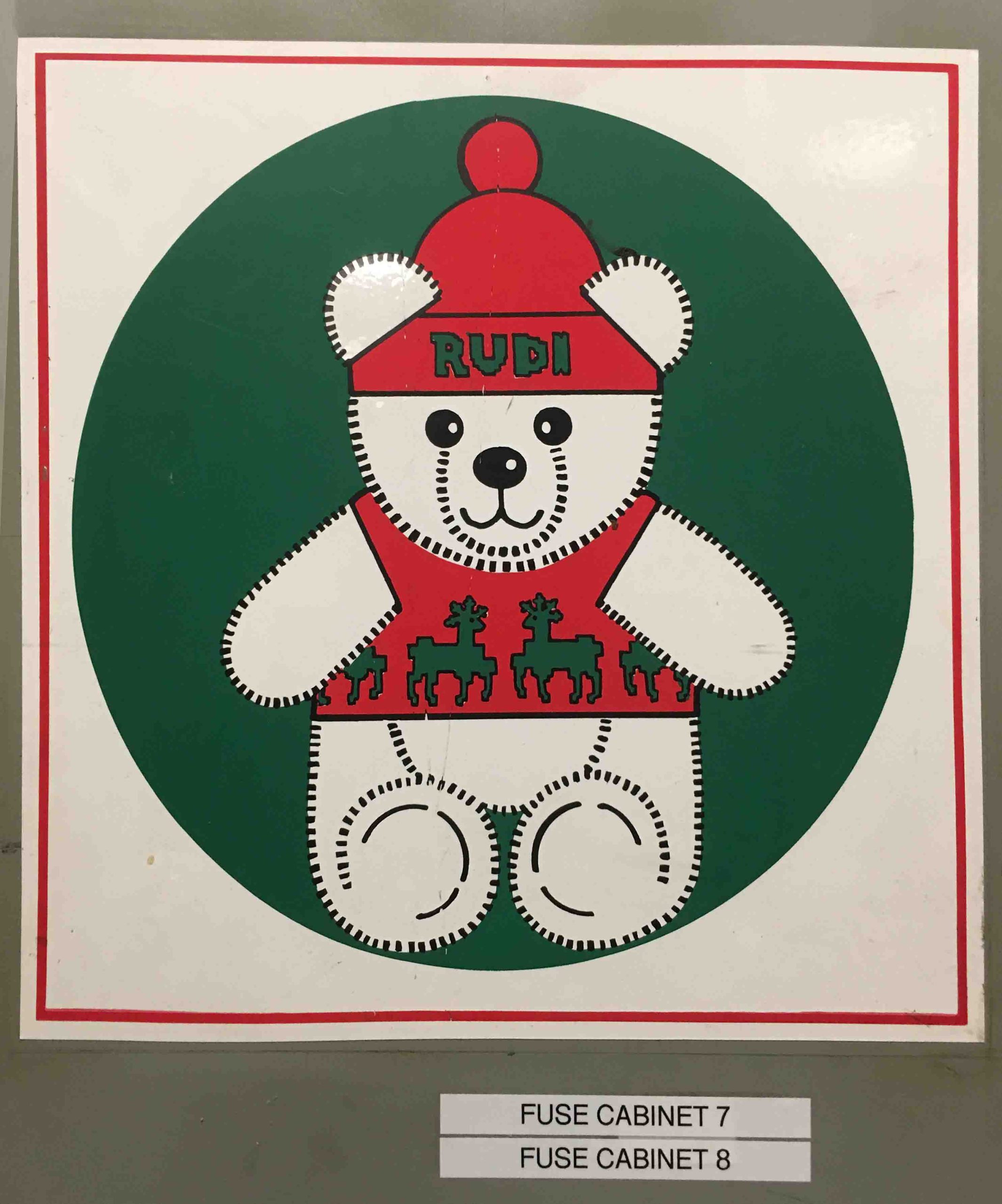
– Many unsafe wiring practices are discovered in the wiring of the figures and many connector failures are repaired.
– After a discussion between Peter Conte, Curt Mangel and Larry Kerecman, plans are made to include the organ in the grand finale music of the Light Show. It will be live when an organist is available and recorded when not available.
– Peter Conte names the Light Show control room “Frosty Central” and Larry Kerecman becomes known as “Light Show Larry.” The Yule season is dubbed “Frostytide.”
– Sam Whitcraft, assistant organ curator, creates a hidden drawer for the organ console to provide controls for the new organ façade lighting, microphone and store background music system. Larry Kerecman programs multi-color lighting presets for the buttons.
– Larry Kerecman designs a recorded audio sound track cutout system, additional console controls, and an indicator light to cue the organist are added to the organ console.
– A suggestion is made to turn the console so the organist can better see the show to synchronize the live music. The console has not been turned in many years but the mechanism is there to do so. Everyone is pleased that it works without harming the cable that runs into it.
– A projected lighting effect on the façade pipes using counter-rotating patterns in a special theatrical fixture is designed by Larry Kerecman to emulate reflections of light on water during the song that used to feature the fountains (“Sleigh ride through the sky.”) The snowflakes and chase effects on the vertical strings of lights are added to keep viewer interest.
– The number of snowmen is reduced to four because of changes in the layout of the figures, thereby enhancing the new visibility of the organ façade.
– The Magic Christmas Tree machine is modified to allow the new control system to operate the big power relays.
– The large Rudi Bear figure and umbilical power feed cable cannot be rewired in time for the opening of the show. It has too many lights on one circuit so the old controller is brought back to handle the 40-Amp circuit to the bear; it is temporarily rigged to operate from the new control system.
– November – completion of the programming and fine tuning of the timing of new show. This is done in the “doghouse” – a temporary shelter set up at end of Grand Court on second floor because you can’t really see the whole show from the stage area. Larry Kerecman and Jim Sale work using remote controls for the show computer and headphones to hear the sound track.
– The critical elements of the show animation effects got done. But despite working long hours into the night there was no time for programming nuances or to fix the last few minor synchronization bugs before the opening of the show on Black Friday.
– Most people will never notice a difference in the way the ballerinas dance or the way Rudi Bear walks these first few days. They are just happy the lights are all working again and busy complaining about the lack of the fountains.
– Some Horizon controller issues cause glitches in the automatic operation of the show. The manufacturer, Entertainment Technology, makes changes to the operating system of the equipment to eliminate many of the problems,
Back in the summer of 2000 ,as we worked on figuring out how everything operated, the Magic Christmas Tree controller held the most mysteries. And it still does to this day. By the time I met Bert Medland, his memory was gone so he could provide no details. The documentation he donated to the Friends of the Wanamaker Organ will have the answers, but no one has the time or interest to pore over the schematics at this point.
There were multiple effects that it could create, each using a separate electro-mechanical mechanism. The “idle time” show between light shows created seemingly endless patterns of colors with the three tiers of lights and the star. That mechanism was amazingly complex, involving timers and stepping relays. The “dazzle” effect was used at the beginning of the show when the tree was announced and that mechanism was quite the mechanical marvel.
But there was yet another mechanism that I never figured out. Then, fast forward to last winter. I found a video of an early show and the voice in the background making comments is none other than Al Goessler! That’s where I learned a few things about when various elements of the show were added.
BUT… thirty-four seconds into the video one can see an amazing “negative chase” of the white lights around the perimeter of the star! I had no idea it could do that but it suddenly came to me that the third motorized mechanism inside the tree controller was to create this effect (visible HERE).
In 2000 when I examined the wiring for the star for the new control system it had only three circuits, one each for white, amber and blue. So that is how the new control system was designed and built.
Well it turns out that Curt Mangel gave the star to organbuilder Charlie Kegg. I had seen it in his garage in Ohio ten years ago. So I called Charlie and asked him to take photos of the back of the star, which I had never seen since Mark Sachetti and crew always handled it during the setup.
Low and behold, the wiring on the back of the star was very complex – to accommodate the chase sequencing. In fact there are 11 separate circuits for the white lights. But it had been modified at some point in the past to tie all of the white light circuits together.
And that is the rest of this chapter of the seemingly endless unfolding story of the Light Show. Who knows what more we may learn?
.
2001:
– A new controller for the Magic Christmas Tree is designed, but budget issues at L&T delay approval of the project.
– Plans to enhance the show, using the sophisticated power of the new computer control system, were abandoned when 9/11 hit.
– A UPS (uninterruptable power system), transient surge protection equipment and revised controllers are installed to address the prior year’s problems with the show which were caused by massive amounts of electrical noise on the power lines. Reliability increases dramatically.
9/11 happens.
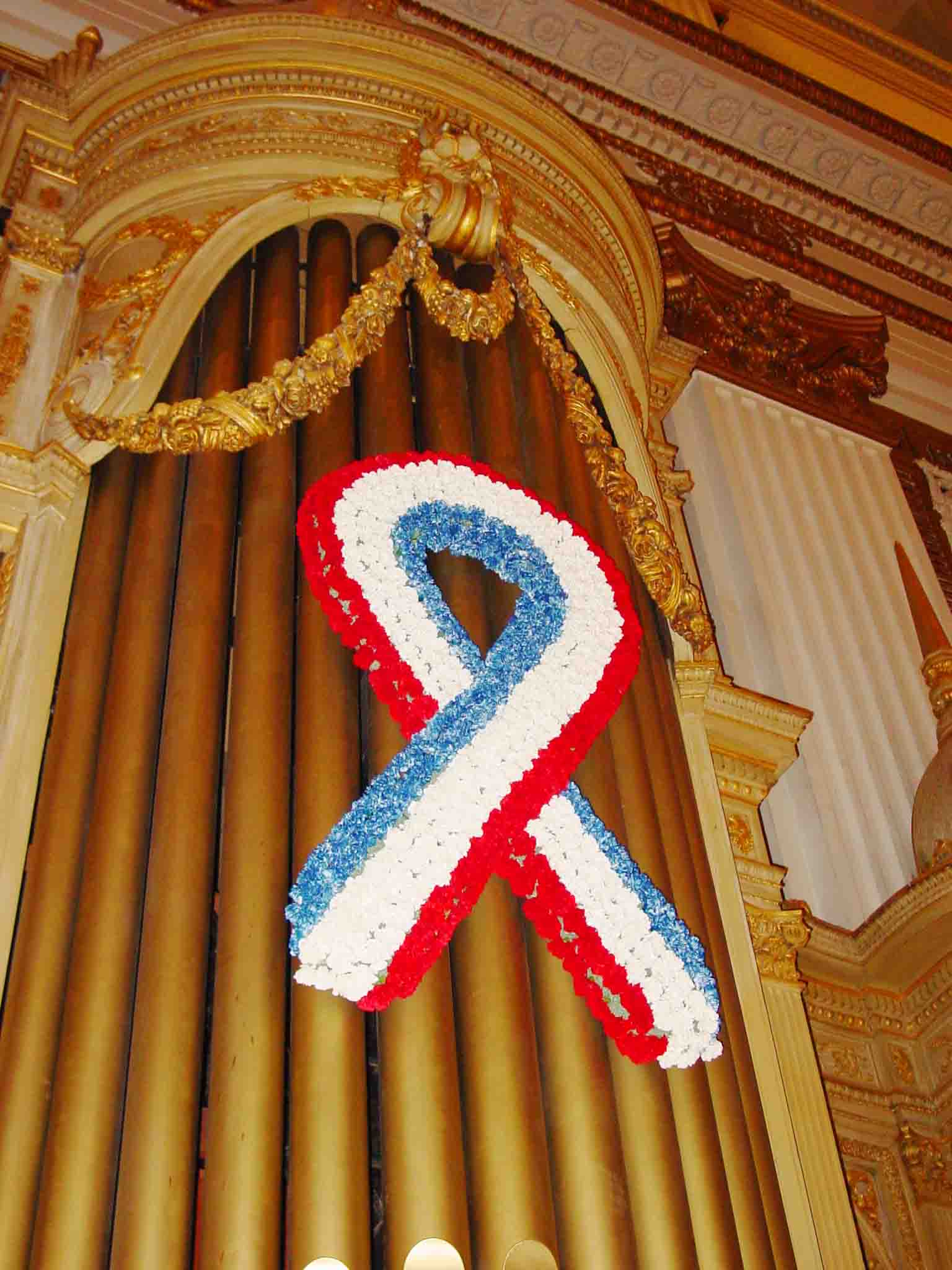
– A large 30-foot by 60-foot American flag is purchased; rigging and a winch are installed to operate it and additional lighting is installed on the 4th floor ledge and stage floor to illuminate it.
– The installation of the flag will prevent the installation of the Magic Christmas Tree.
– (The original Tree will never be set up again.)
– The audio cutout system is programmed to mute the words “and introducing the Magic Christmas Tree” automatically.
– “God Bless America” is added for the sound track finale and live playing.
– A glitch is discovered in the train song time code track; a firmware modification is made to the Horizon controllers to allow the time code to free-wheel internally when the incoming data is temporarily lost.
2002:
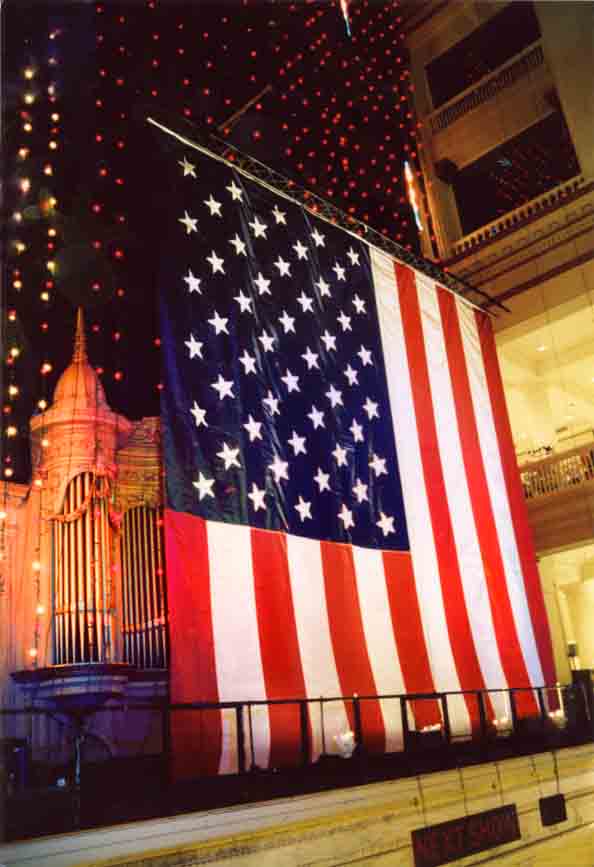
– Three Philadelphia-area professional rigging companies are interviewed and given site tours for the purpose of outsourcing the installation and teardown of the show in 2003.
– The L&T store engineers are not happy about this and mouth off during the tours. One of the companies withdraws from making a proposal, citing bad working conditions.
– A decision is made in New York to keep the flag for 2002.
– A new “NEXT SHOW” clock is installed at the edge of the balcony railing.
– Fuses are installed in the verticals since there is no fuse panel in the control room
– Money is tight at L&T, so several planned wiring improvements are cancelled, including the 4th and 6th floor rewiring.
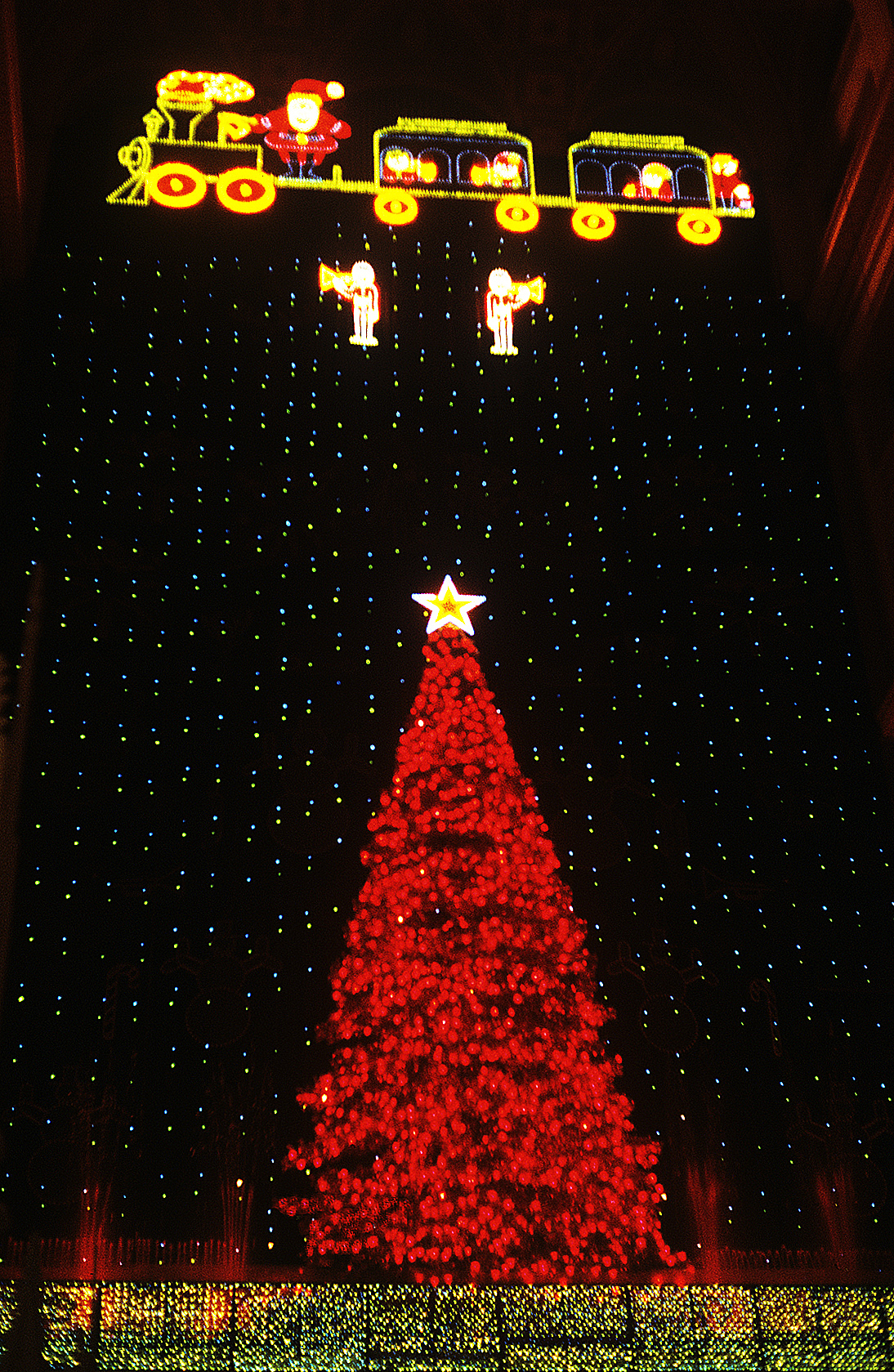
– An accident occurs while the train is being pulled into position. Improper rigging techniques resulted in a sudden 10-foot drop of the train. No one is hurt.
-T he Light Show runs 310 shows without a single glitch. A few shows did not run because the start times were not properly programmed into the building EMS (energy management system) which triggers the shows.
2003:
– Outsourcing of the show loadin/loadout is rejected by New York because the price is “too low.” The Lord & Taylor store engineers reportedly badmouthed the proposal because it would cut most of their lucrative overtime pay.
– A decision is made in New York to eliminate the train because it is “not safe.” This also was not based on facts, just a lack of safety training on proper rigging methods.
– Larry Kerecman is given a contract to eliminate the train from the sound track of the show. – The new sound track is prepared but Larry decides that he does not want to participate in dismantling any more of the Light Show and resigns from the project.
– Arnold Tang is brought on board to program the elimination of the train from the Light Show.
2004-2005:
– The Light Show stays essentially the same during tight L&T budget years.
2006:
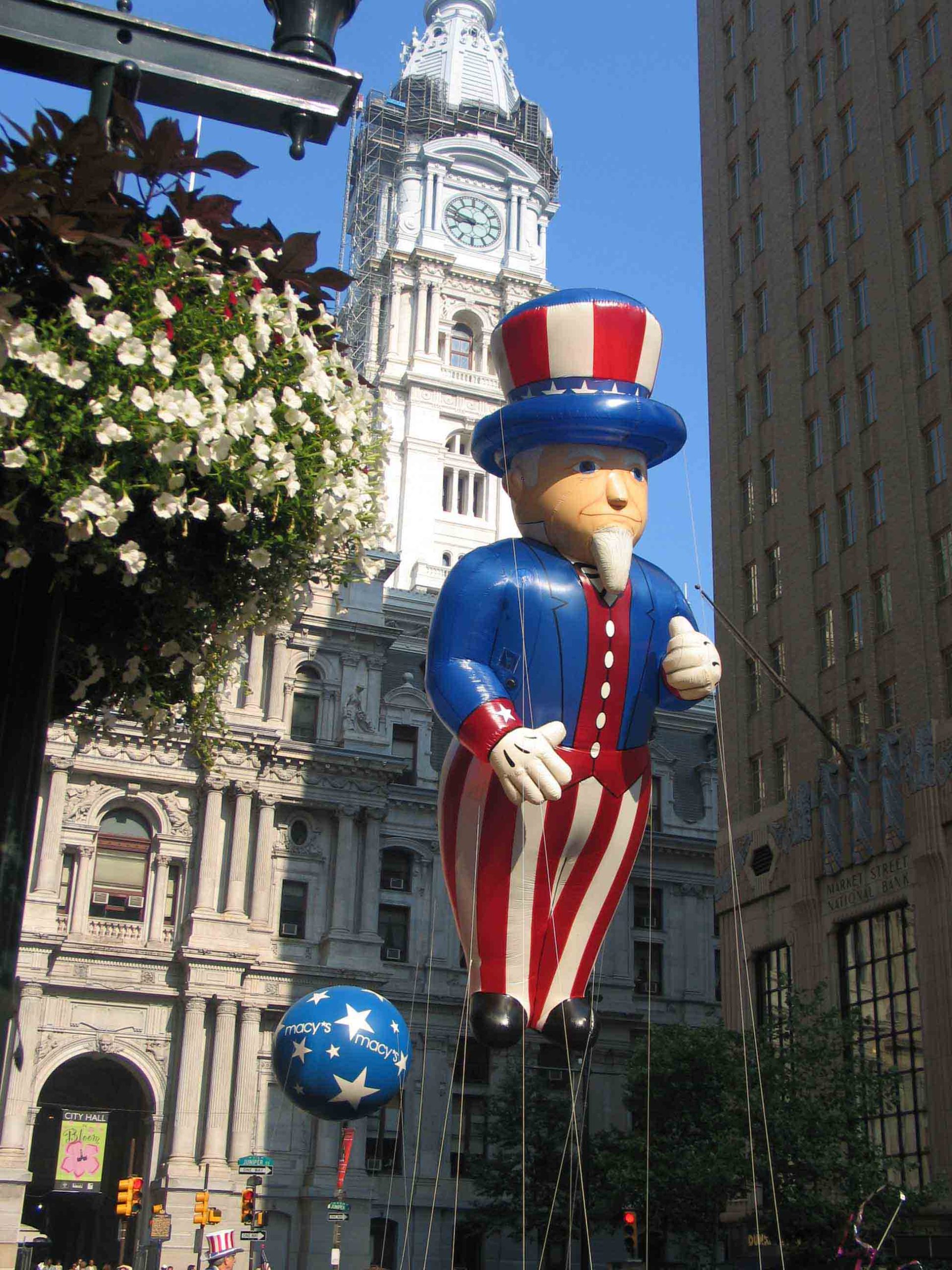
– Macy’s uses L&T engineers to help set up the show for their first year of operating the store.
– The train is restored to the show and the Rudi Bear song is eliminated.
2007:
– The show figures are taken to the Macy’s Parade Studio in Hoboken, NJ and new ones are built on lighter weight flats with large holes in the panels to block less of the Wanamaker Organ sound.
– LEDs are used in place of incandescent lamps except for the white and blue blinkers on the 28 vertical light strings.
– The large Rudi Bear, VW bug, sleigh and soldiers are eliminated from the show. The new Rudolph looks like a deer instead of Bullwinkle Moose.
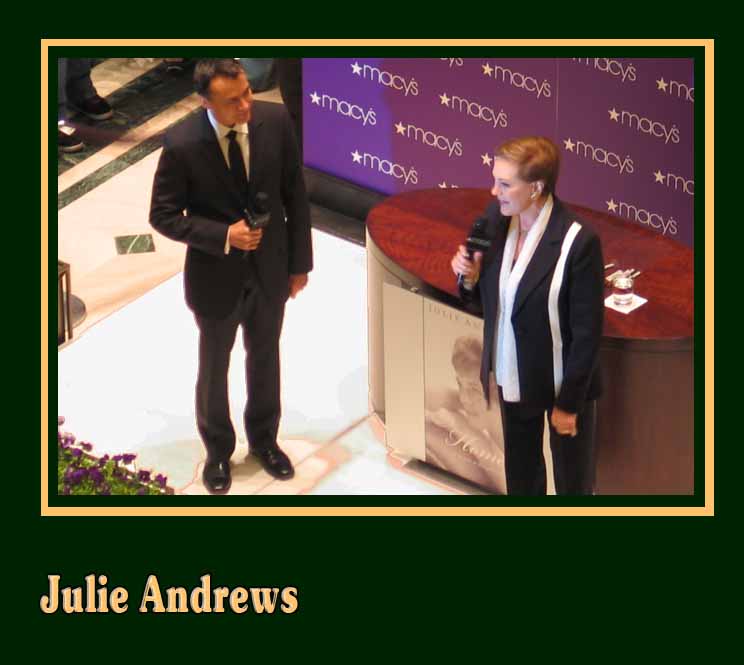
– A new rigging system with four large winches in the attic above the skylight and black horizontal trusses suspended at regular intervals to hold the Light Show figures are installed.
– A slot is created in the floor of the stage so the figures don’t have to be lifted up to stage level from the hallway storage area before they are attached to the trusses.
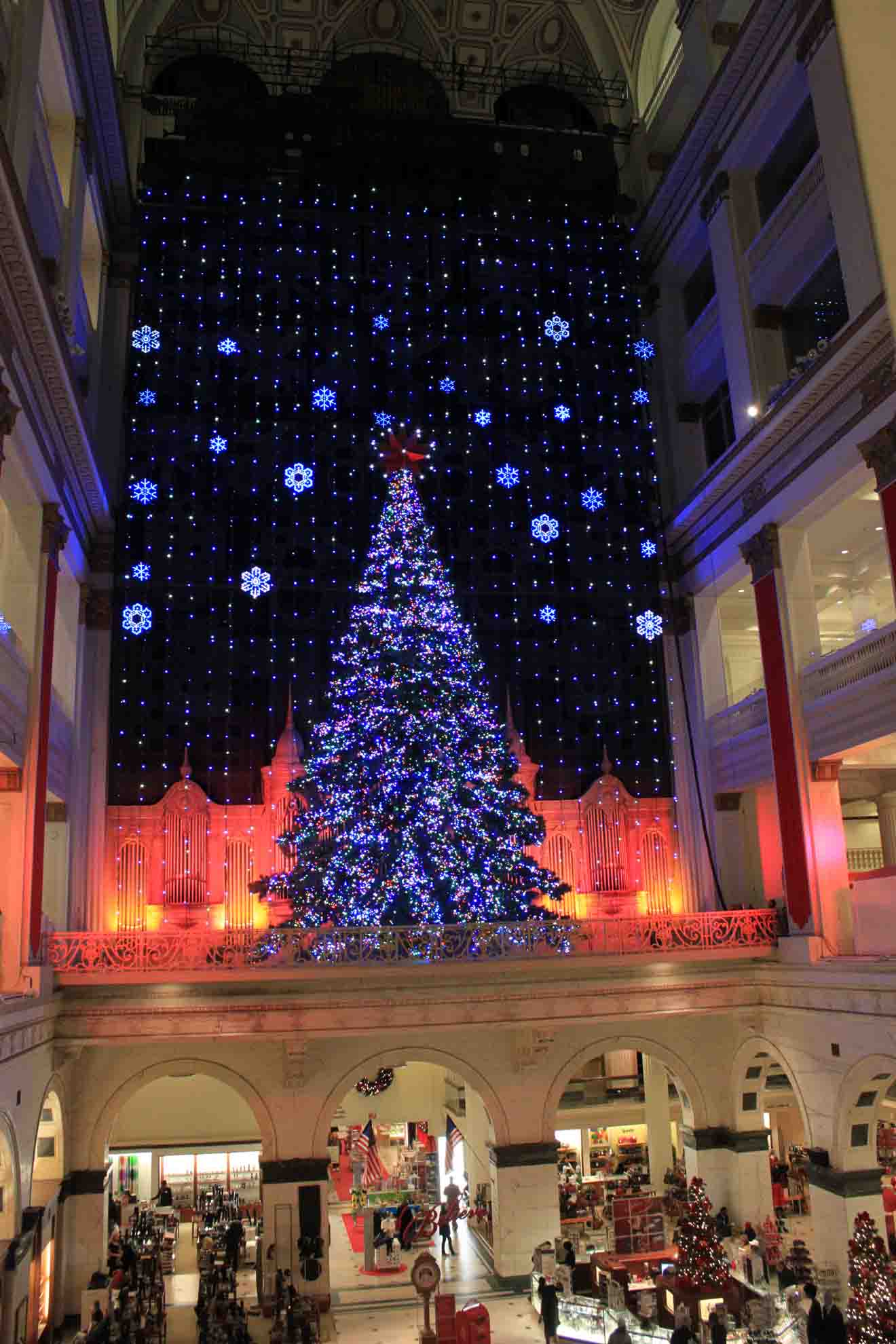
– Setup of the show now takes four nights instead of 2-3 weeks.
– Four moving lights are set up on stage to provide additional light animation with patterns projected onto the walls and ceiling of the Grand Court.
– The 2006 sound track is used.
– Larry Kerecman assists with the setup and also rescues more of the historic Light Show equipment from various storage locations on the 2nd floor and moves them up to the organ shop. The Dancing Waters fountain control panel is also located and moved.
2008:
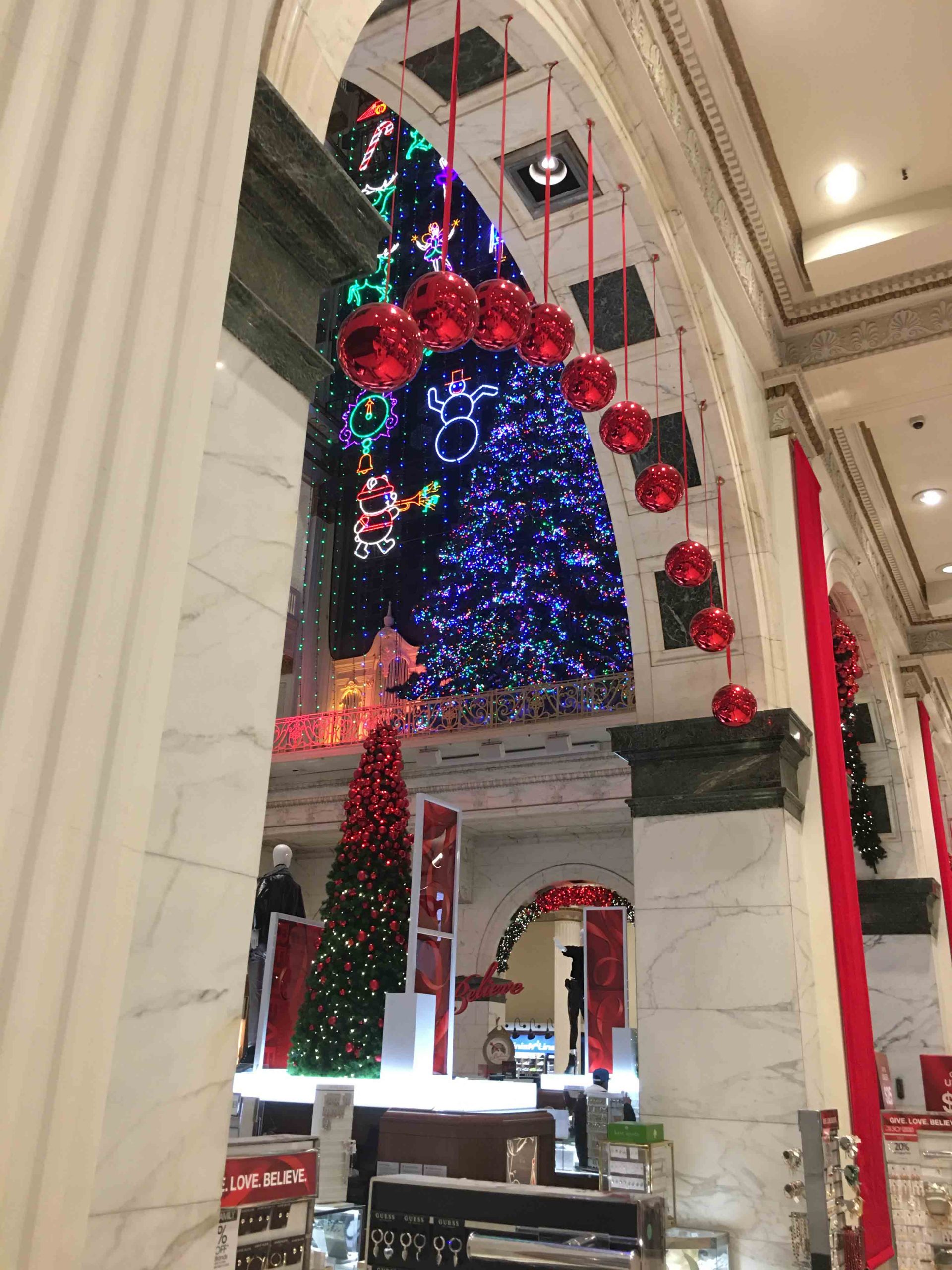
2009 – present:
– The Friends of the Wanamaker Organ preserves many of the Light Show control panens in its museum on the Wanamaker Building Fourth Floor (shown during Organ Tours).
– Macy’s continues to make improvements in the wiring and controls each year.
– Many more snowflakes are added.
– Changes to the sound track are made, with Julie Andrews doing the narration.
– Improvements are made to the audio system in the Grand Court, since it has been difficult to hear the narration above the first floor.
– All of the Dancing Waters fountain show pumps and nozzle manifolds are discarded. A few sprays remain.
– This may have been the last known intact set of fountain equipment left in the United States that was built in Germany by Otto Przystawik.
– The other Dancing Waters fountain shows were purchased by Mike Connery from the Steinman estate—but according to Bill Wells, who worked for Connery—when Connery went out of business all of his equipment was sent to a scrap dealer to reimburse creditors. The musical fountain company is still in business, and some of their offerings may be enjoyed HERE.
2019: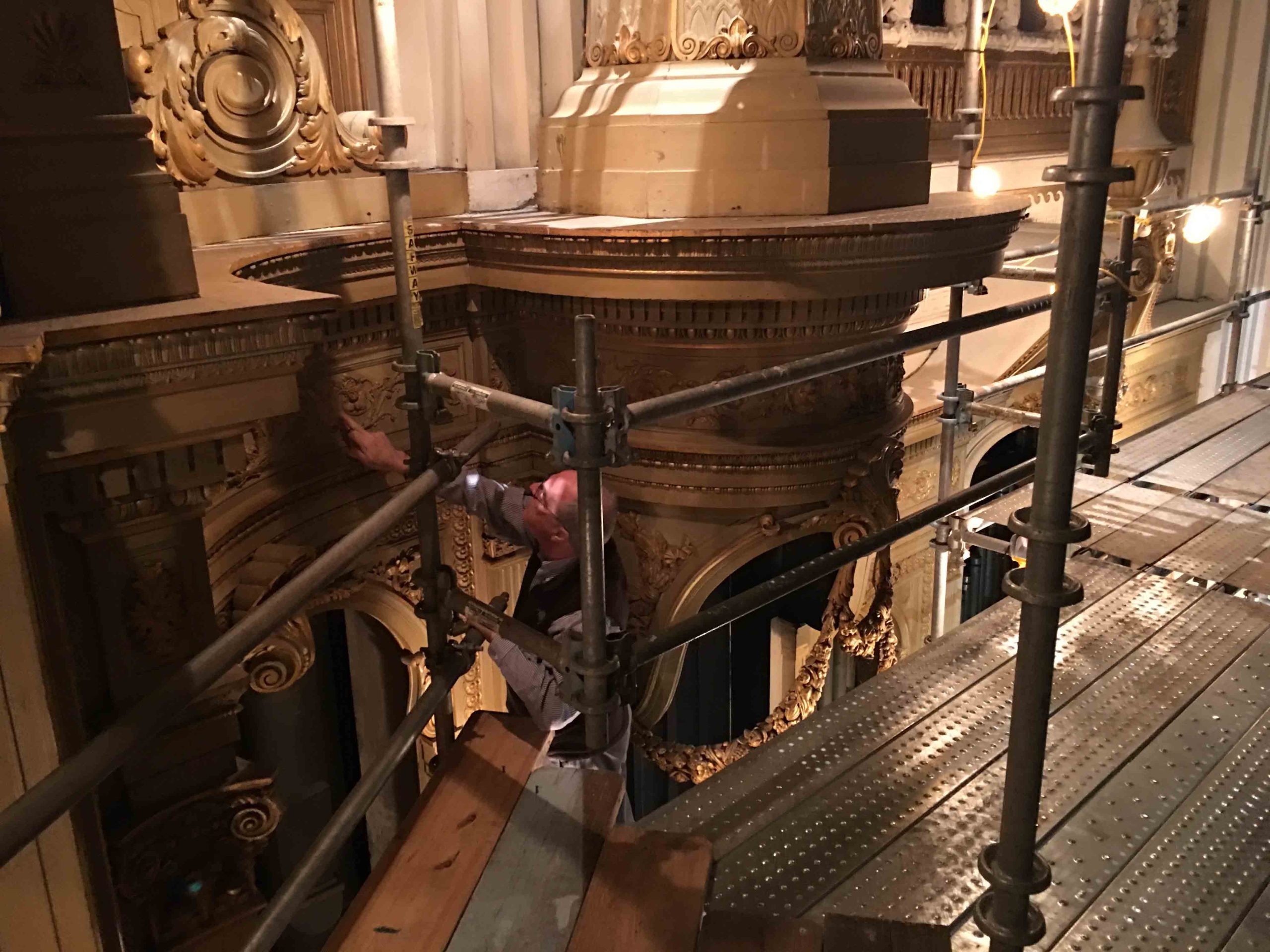
2020:
– Pandemic concerns about crowds cause Macy’s to feature only Virtual versions of the Light Show and Dickens Christmas Village, although the Light Show Wall is entirely lit during the shopping day.
2021:
– The shows resume on an attenuated basis as pandemic concerns continue.
2022:
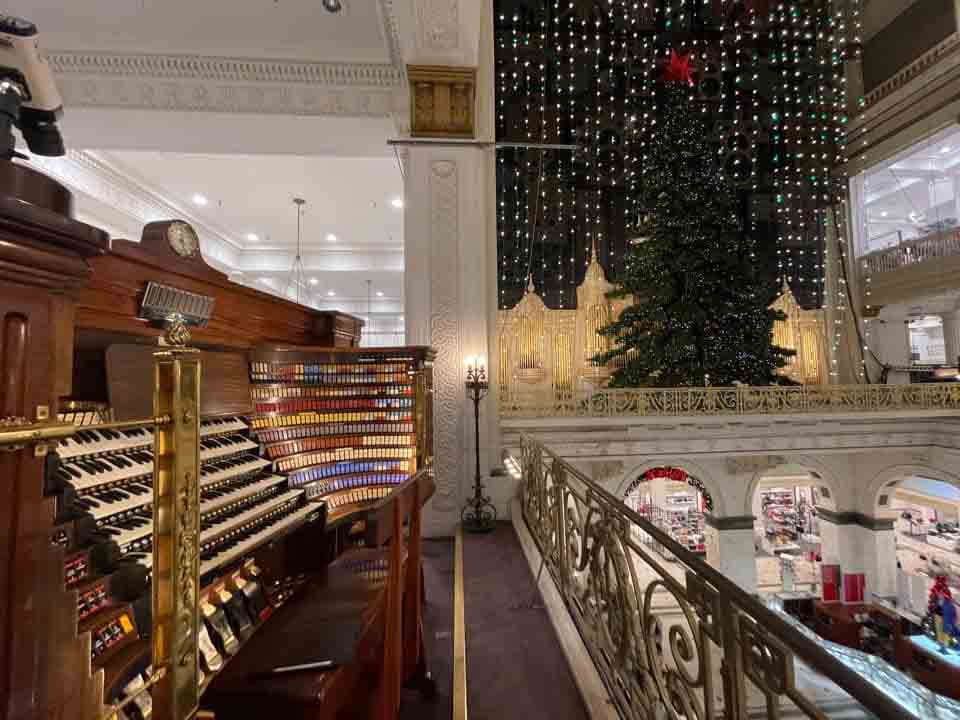

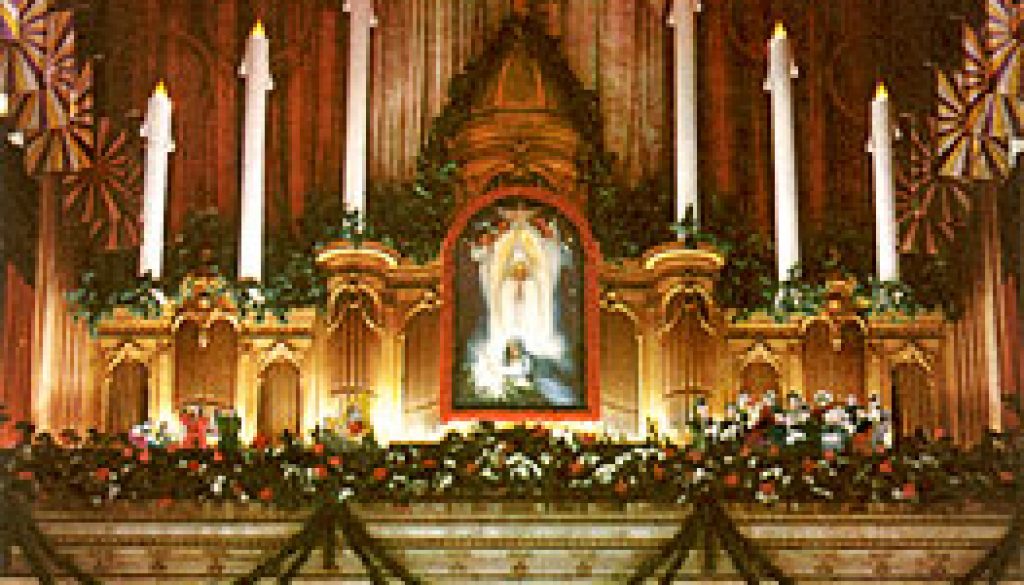
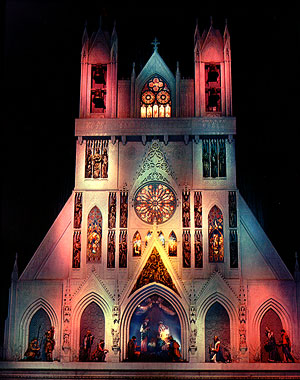
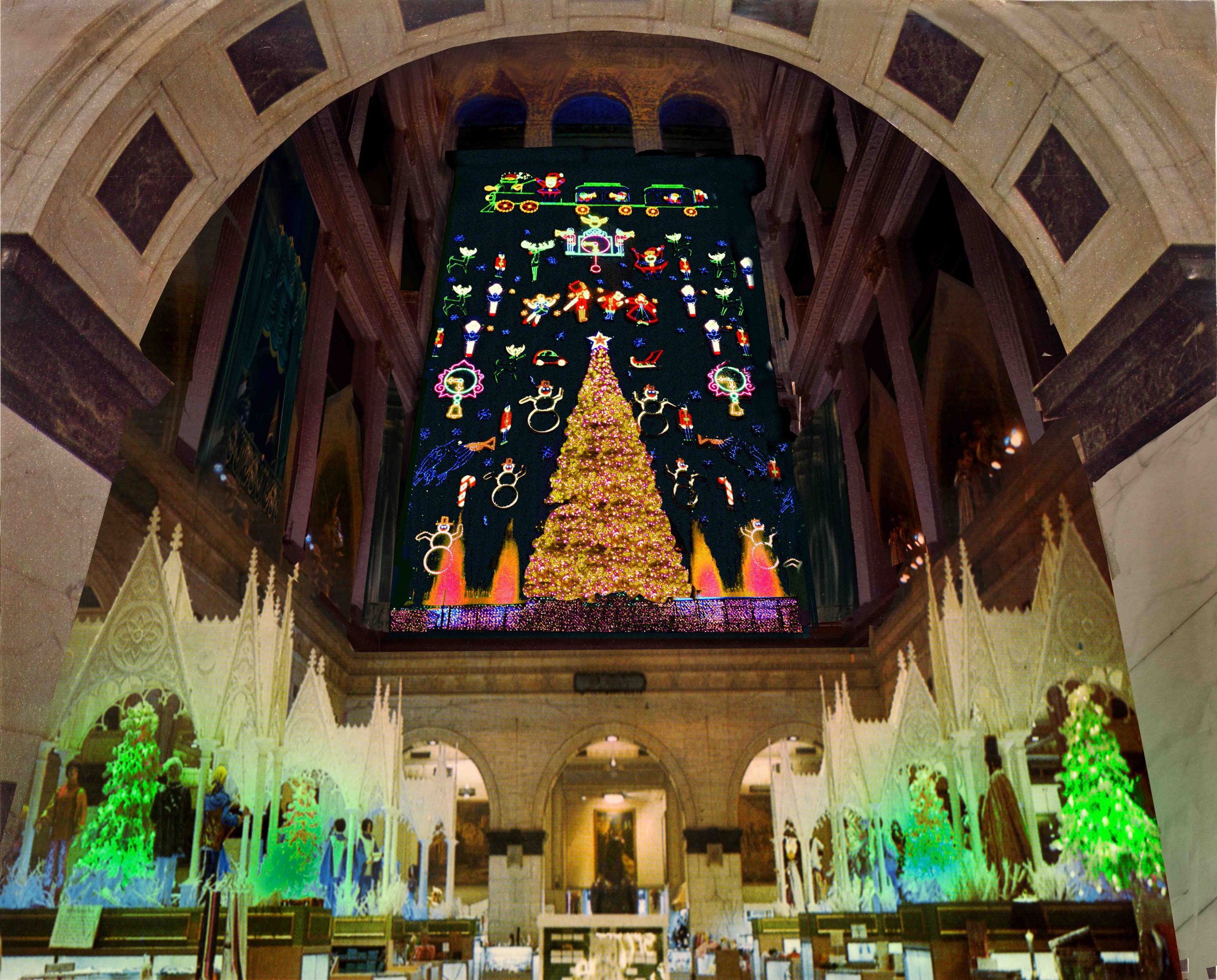 Yet another manual control panel operated the lights on the props and figures displayed above the fountains.
Yet another manual control panel operated the lights on the props and figures displayed above the fountains.